There are over 10,000 types of birds in the world. They range from big to small, and although it’s impossible to know about them all, they have plenty of qualities in common that place them in the Aves class of the animal kingdom.
Whether birds interest you or you’d just like to know more about them, we’ll cover key information about some of the many bird species out there. You’ll learn about the most known birds, from their history to unique features.
Different types of birds have attributes that make them as unique as humans, and knowing about them lets you appreciate what mother nature has to offer.
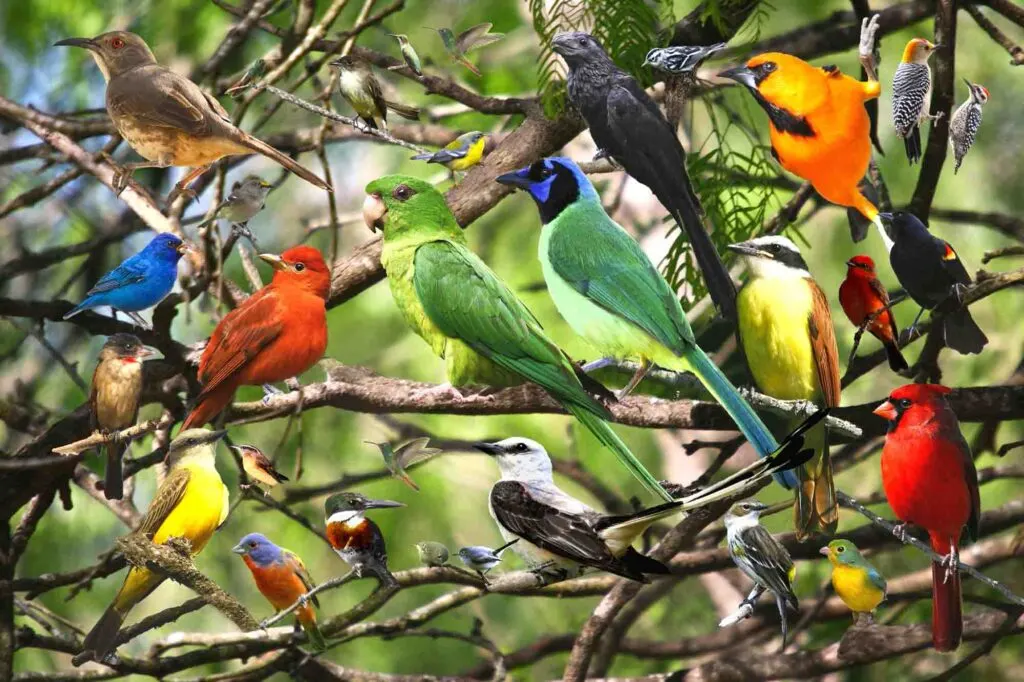
What Is A Bird?
You may know what birds are, but what makes them birds? No matter how many types of birds there are, they all have a commonality.
Birds are classified as endothermic vertebrates, so they can regulate their own temperature and have an inner skeleton, which is hollow, by the way, to allow easy flight.
In addition, they have feathers, wings, and a spindle-shaped body to make the flight comfortable.
Instead of a mouth with teeth, these curious animals have a beak. Also, they are bipedal, meaning they use only two legs for walking.
They vary in size from 2 inches to 9 feet 2 inches. Every type of bird hatches from a hard-shelled egg, which is fertilized internally.
Collective bird nouns: a flock of birds (generic noun for any type of bird) and a flight of birds (when in flight).
History And Evolution
Did you know that birds are the only dinosaurs still alive today? Birds are theropods, which is the same classification as a T-rex!
A theropod is a bipedal animal with three toes and claws on each limb. The oldest bird species existed 150 million years ago and closely resemble today’s birds, except they had teeth. Current-day birds lost their teeth during their evolution.
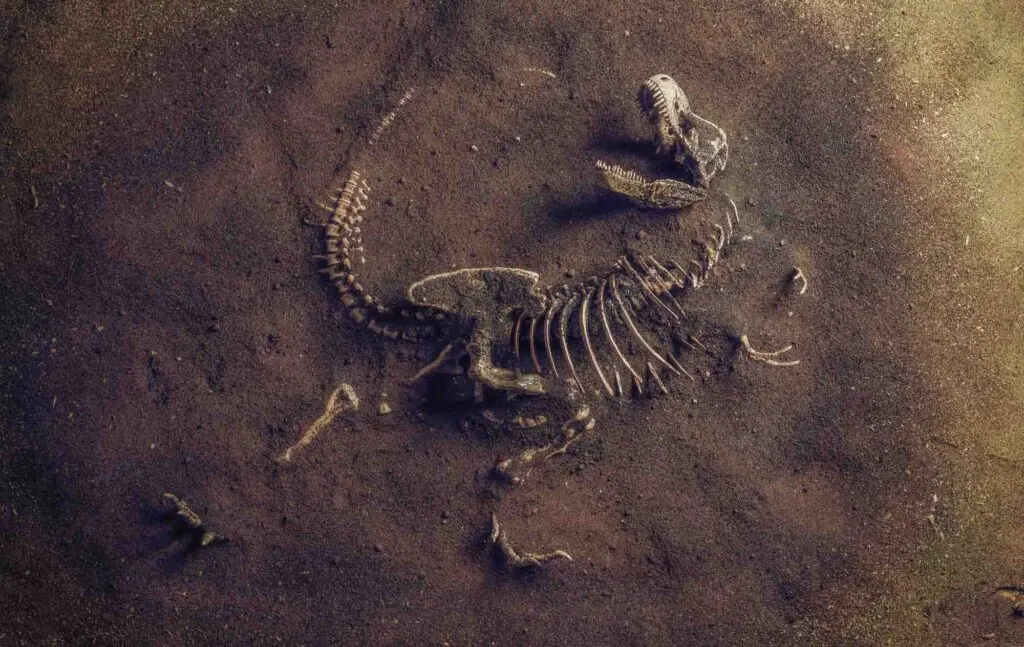
Bird’s Classification
Types of birds are divided into two groups: Palaeognathae, which are flightless and weak flying birds, and Neognathae, which all other birds fall into.
Palaeognathae only contains six of tens of thousands of bird types, including ostriches, kiwis, rheas, tinamous, emu, and cassowaries.
Bird’s Behavior
All types of birds chirp or sing to mate, warn others of danger, or scare predators.
Some of them even dance to attract a mate – even chickens do, but it’s a different type of chicken dance to the one you know!
Also, all bird species lay eggs. Most birds live in flocks for safety, and many migrate to different locations throughout the year to find food or mate.
Bird Types
Different types of birds have common DNA traits that group them together, and this list has 40 orders of birds with varying species within the type mentioned.
Knowing about different bird types will give you fascinating insight and a newfound appreciation of the birding world.
Here are the 40 orders with a few species of birds that fall within each one of them.
Ostriches (Struthioniformes)
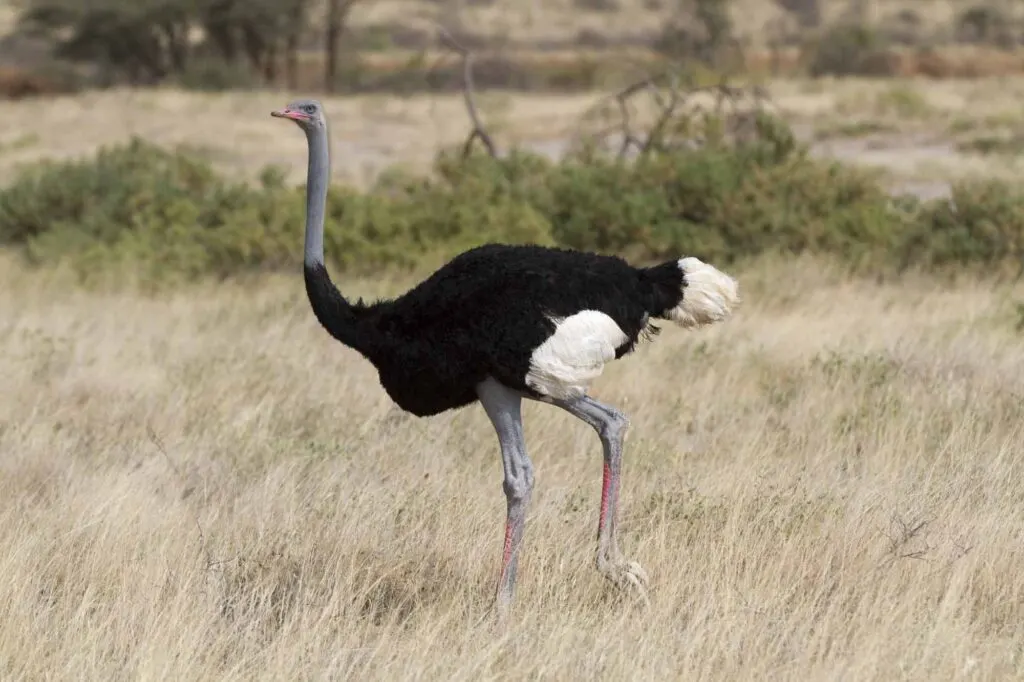
Ostriches are the giants among our feathered friends, weighing 220 to 350 pounds.
They have the largest eyes of any mammal on earth regarding their body ratio and lay the biggest eggs of any type of bird.
They do have wings but can’t fly; however, they make up for it by being able to run 43.5 mph, making them one of the fastest land animals!
Ostrich farming is common worldwide for meat, leather, feathers, and eggs. The Philippines and Namibia have the largest ostrich farming industries.
These flightless birds are native to Africa but were commonly found across Asia in ancient times.
Different species: There are only two ostrich species–the common ostrich and the Somali ostrich.
Read next: 14 Biggest Animals in the World
Rheas (Rheiformes)
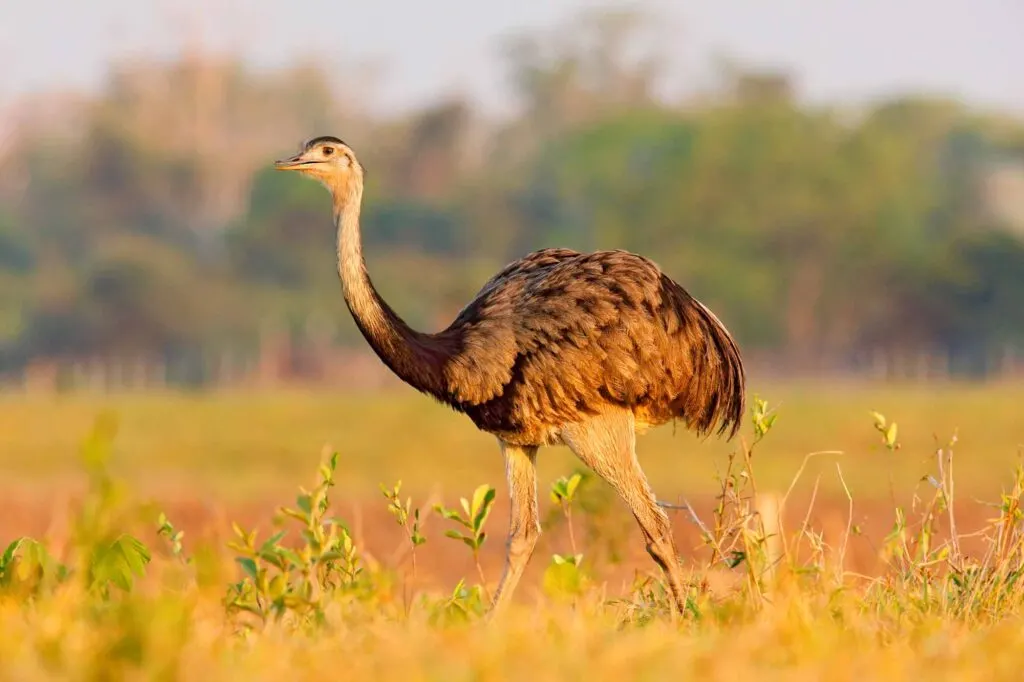
Rheas look like ostriches and are even called South American ostriches. This omnivorous bird type weighs up to 50 pounds, making them the largest South American bird where they are native.
They are flightless, have long necks and legs, and reach up to 5 feet tall. They eat seeds, fruit, small insects, lizards, and small birds.
Rheas prefer to live in open land like grasslands and are known to live up to 15 years in the wild.
They live in solitude until the mating season arrives. Humans farm them for meat, eggs, feathers, and leather.
Different species: American rhea, Darwin’s rhea, and Puna rhea.
Kiwis (Apterygiformes)
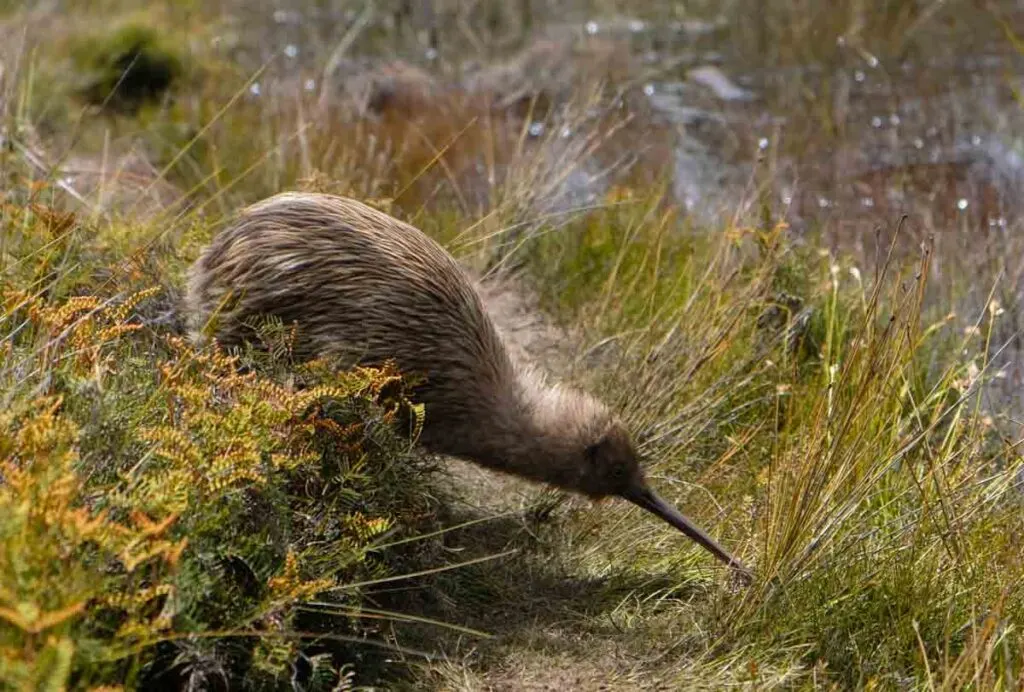
Another flightless type of bird is the New Zealand national bird called a kiwi. These birds are special enough for New Zealanders to be called kiwis.
Kiwis are about the size of chickens, covered in brown feathers, and have thin, elongated beaks.
They are a near-threatened species, with only around 24,000 remaining, and decline by an estimated 5.8 percent per year.
Kiwis are protected in reserves and national parks. They live up to 60 and eat an omnivorous diet of insects, seeds, and berries. Their eggs are enormous in proportion to their body size, which is around 15% of the female’s body weight.
Different species: Great spotted kiwi, little spotted kiwi, brown kiwi, southern brown kiwi, North Island brown kiwi.
Tinamous (Tinamiformes)
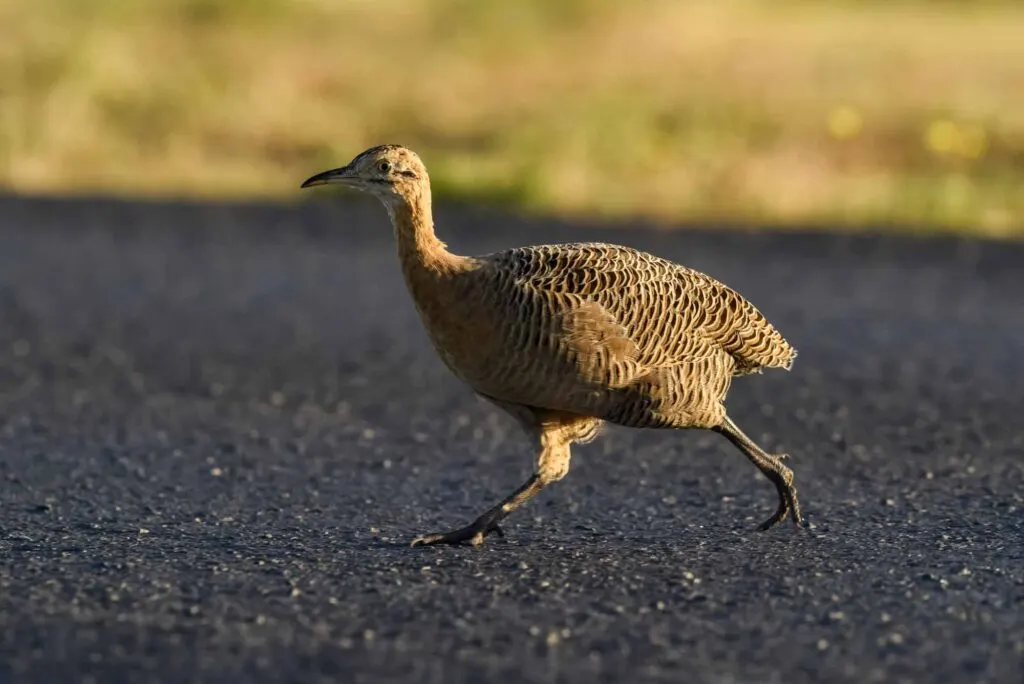
Tinamous fall into the Palaeognathae types of birds, but they can fly partially, unlike their ostrich, rhea, and kiwi friends.
These birds range from 6 to 20 inches and have a small head and sizeable feathered rump with feather-hidden wings.
Tinamouses are ground dwellers who can fly but prefer to run, but they get tired quite quickly, so they are experts in hiding.
They live in various habitats, from forests to open land, all over Central and South America. Some tinamous species like to live alone, while others prefer a flock.
South American people love to hunt this bird type because they’re quite tasty.
Different species: There are 47 tinamous species; the most known is the great tinamous.
Emu And Cassowaries (Casuariiformes)
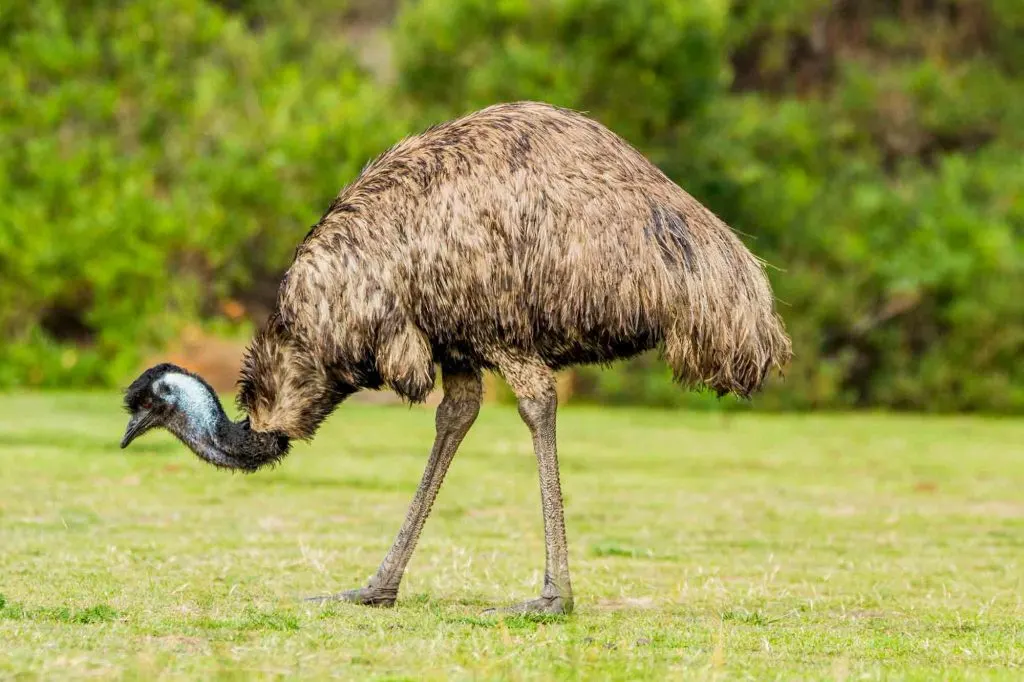
Emu and cassowaries are different types of birds, but they are closely related. Emus come second as the tallest bird next to ostriches, reaching 6 feet 2 inches.
They have long brown feathers, long necks, and legs and can run up to 30mph but can’t fly. They are native to Australia and also their national bird.
Cassowaries are found in Northeastern Australia and the tropical forests of New Guinea and the Aru Islands.
These birds are flightless and have colorful necks and faces with black bodies. Females are more colorful and larger. Cassowaries grow up to 5 feet 11 inches tall and weigh around 130 pounds.
Different species: The three emu species are the common emu, Kangaroo Island emu, and King Island emu. Cassowaries have Southern, Northern, and dwarf cassowary species.
Chickens And Relatives (Galliformes)
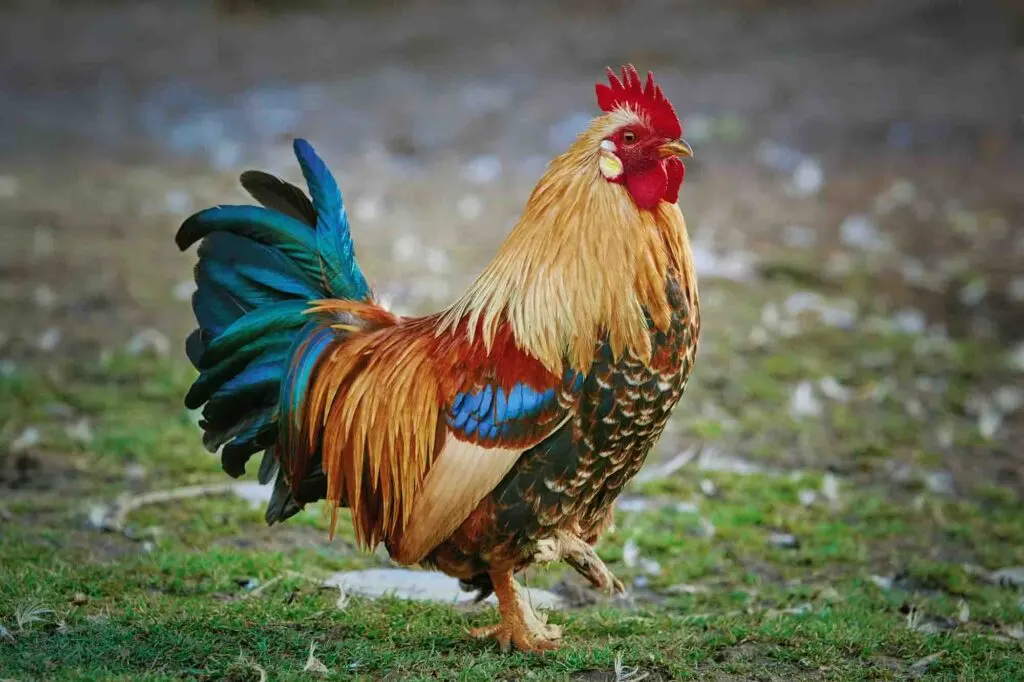
Chickens, classified as Gallus gallus domesticus, are domesticated and by far the most common birds you can find almost anywhere in the world, but they are originally from South Asia.
As you probably already know, these landfowls get farmed for their meat and eggs, and humans have been doing so since the Stone Age. Chickens also have cultural significance in folklore and religion.
The average lifespan of a chicken is between 5 and 10 years. They do fly, but not very far or high.
They’re also intelligent birds, and scientists have even discovered that chickens can demonstrate problem-solving skills, effective communication, and empathy.
Different species: Gallus gallus domesticus is the only chicken species, but there are hundreds of differing breeds.
Ducks And Relatives (Anseriformes)
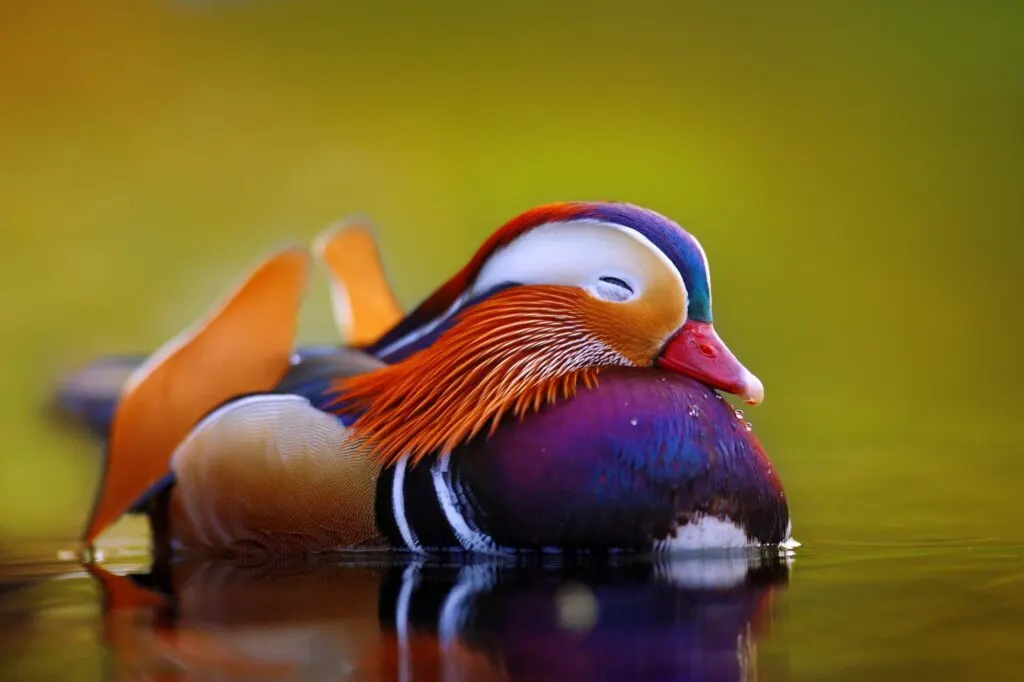
Ducks are water birds amongst types of birds and are known as waterfowl. They are small, with short necks, waterproof feathers, and webbed feet.
There are around 100 known species of ducks, and they’re found on every continent besides Antarctica.
Although they love to swim, ducks are well adapted to fly and live on land. They are social birds that form paddling groups to protect themselves from predators.
Swans and geese are of the same family of waterfowl as ducks. Swans are the largest flying birds. Geese are smaller than swans but larger than ducks.
Different species: The most known are the domestic and Mallard ducks. Swans only have six species; the most known is the Mute swan, and geese have gray, white, black, and snow species.
Grebes (Podicipediformes)
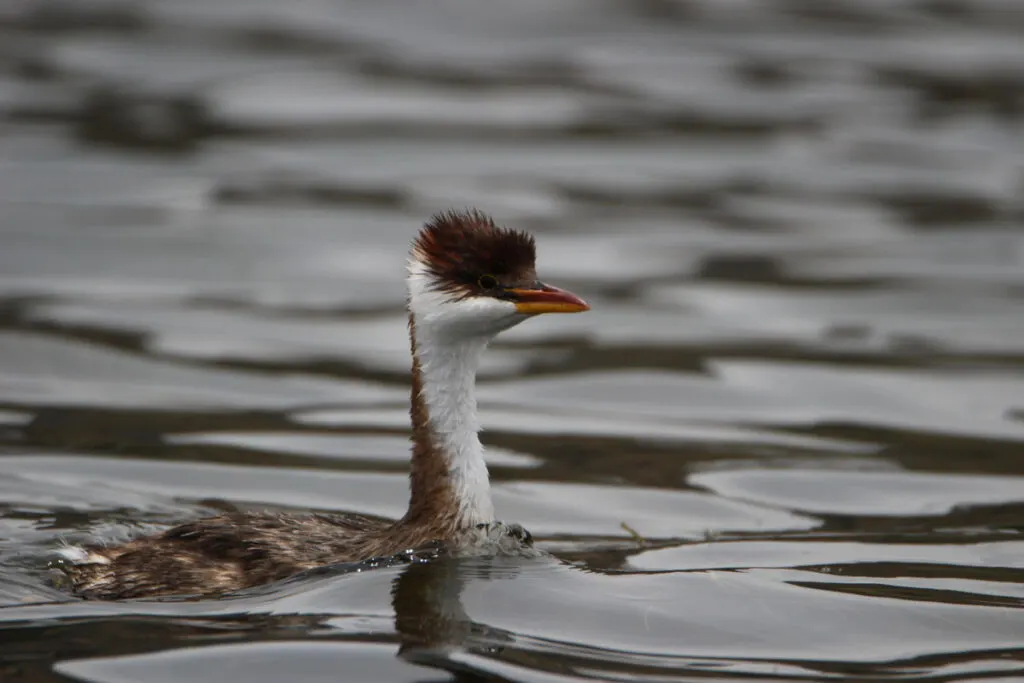
Grebes are commonly mistaken as ducks but are their own species. They are rather funny looking with similarities to coons and loots and are closely related to flamingos.
Grebes are found in North and South America, Europe, Asia, Africa, and Australia.
Depending on the species, grebe types of birds weigh between 5 ounces and 3 pounds.
Different grebe species range from 8 to 29 inches in length and have varying beak shapes, but all have ornamentation on their heads.
Different species: There are 20 grebe species. The most common are Neogaeornis wetzeli, pied-billed grebe, and western grebe.
Mesites (Mesitornithiformes)
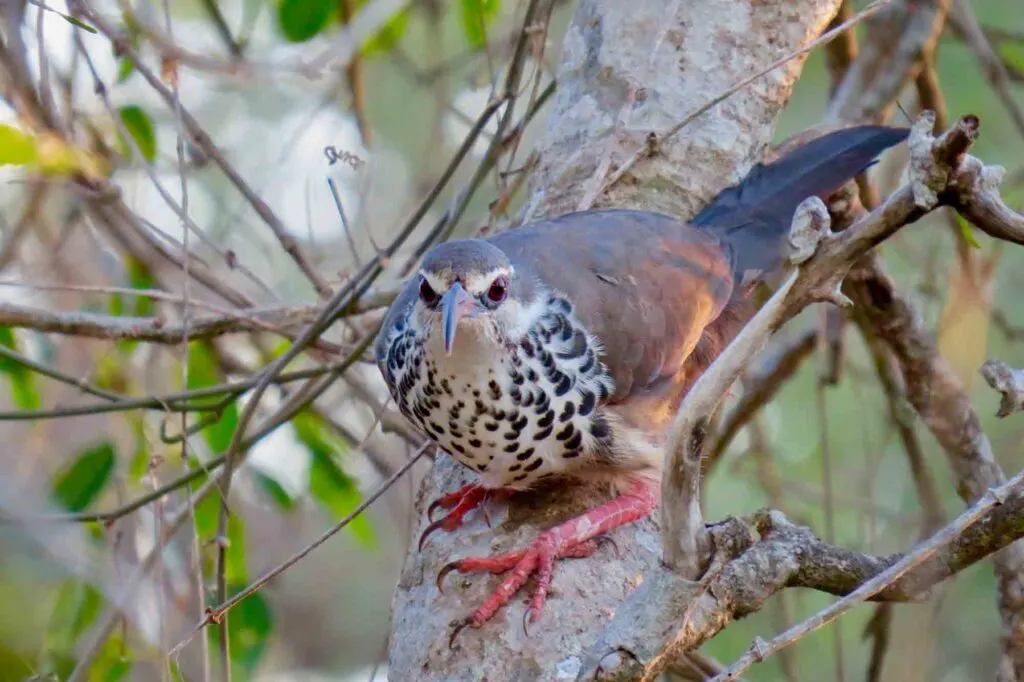
Mesites are a bird type living in forests and endemic to Madagascar. They are partially or entirely flightless.
Mesites are 12 inches long, with a thick tails, short wings, and brown feathers. They forage the ground for seeds and insects. Sub-desert mesites use their bills to probe soil.
They like to live in pairs or flocks and mate monogamously. Mesites are very vocal and make noises to keep others out of their territory.
All mesite species are endangered and listed as vulnerable to extinction.
Different species: The three species are the brown mesite, white-breasted mesite, and sub-desert mesite.
Flamingos (Phoenicopteriformes)
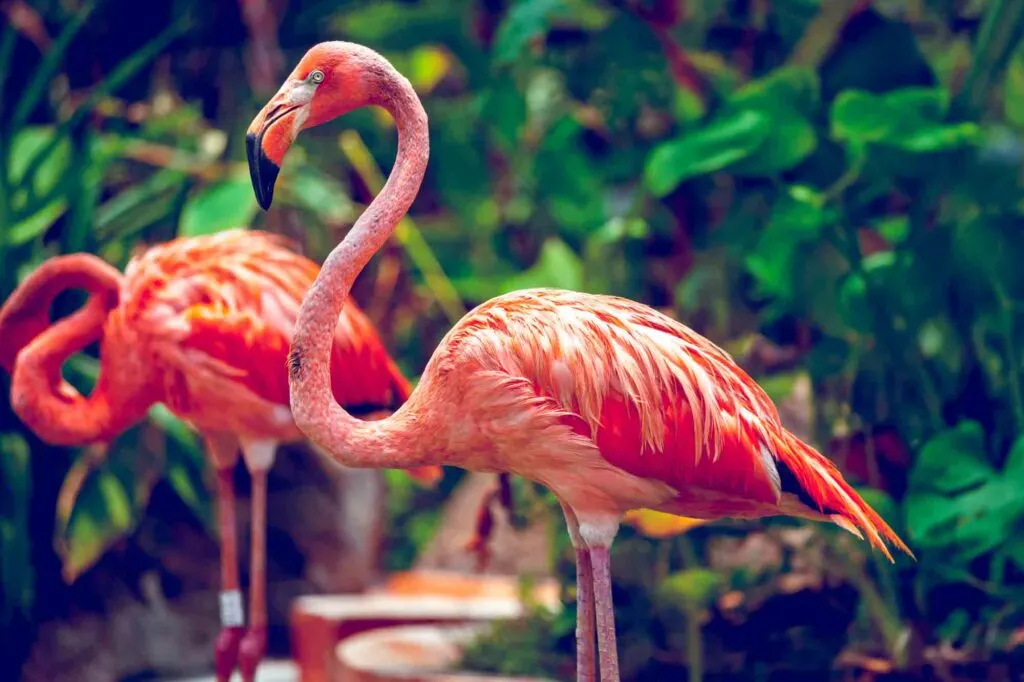
Flamingos are gracious wading birds with six species, which are native to the Americas and Afro-Asia.
These beautiful birds acquire their cheerful color from the aqueous bacteria and beta-carotene from their food sources.
The more vibrant a flamingo is, the healthier these types of birds are—which is also a strong signal for potential mates.
They feed on insect larvae, plankton, mollusks, crustaceans, and small insects.
Flamingos are very social and noisy birds, living in massive colonies, and varied vocalizations.
Appearance-wise, flamingos range from 2.6 to 4.7 feet in length and weigh 5.5 to 7.7 pounds. Flamingos can have a wingspan between 37 and 59 inches.
Different species: Chilean flamingo, greater flamingo, American flamingo, lesser flamingo, Andean flamingo, and James’s flamingo.
Did you know? The name flamingo comes from Portuguese or Spanish flamengo, which means flame-colored.
Pigeons And Doves (Columbiformes)
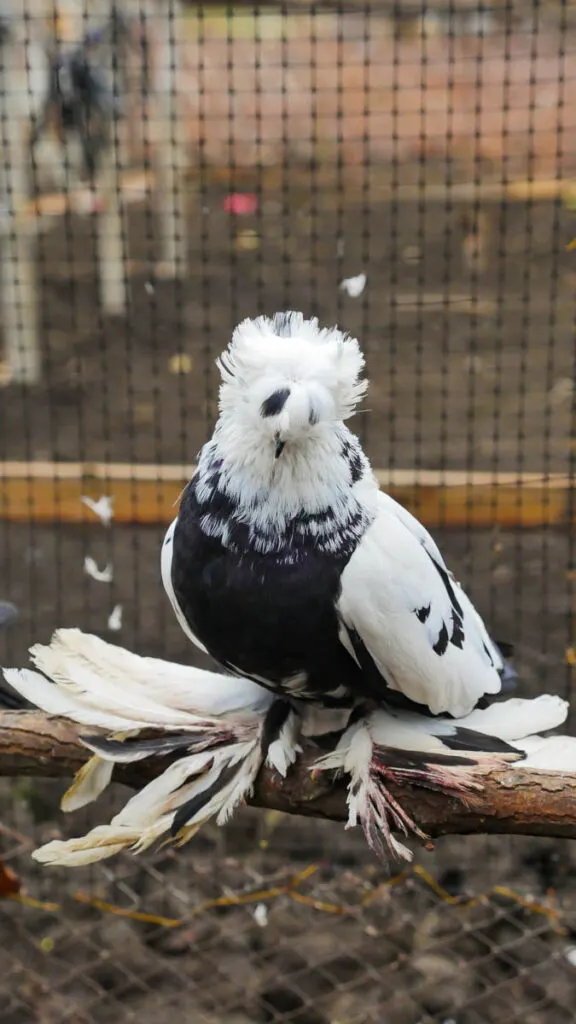
Pigeons are a group of birds that belong to the Columbidae family. Although many of us regard pigeons and doves as different birds (genetically speaking), they are the same thing.
The difference is “etymological” (relating to the origin of words). The word “pigeon” comes from the French, while “dove” is of Nordic origins.
However, many agree that a pigeon denotes a bigger bird, while doves are smaller.
Different species: There are roughly 351 different types of pigeons and doves in 5 subfamilies and across 50 genera, but some interesting species are the Nicobar pigeon, Carneau pigeon, and Victoria crowned pigeon (which is the largest species of pigeon!).
Sandgrouse (Pterocliformes)
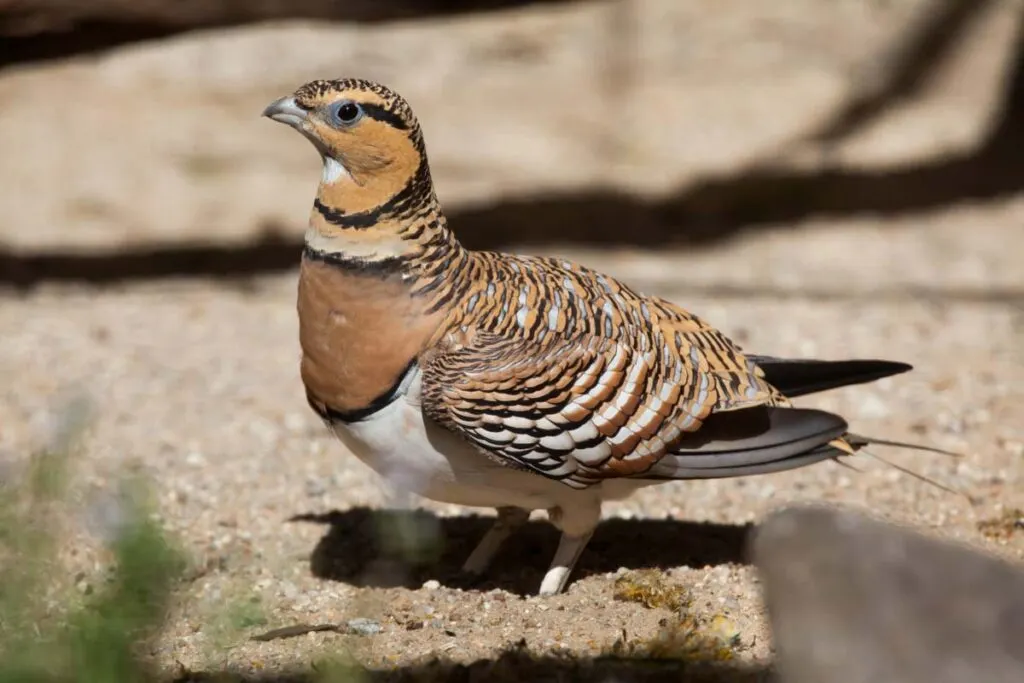
Sandgrouse is found in Africa and Asia, living in open planes like grassland, savannas, and semi-desert terrains.
They have small heads like a pigeon, fat bodies, and short legs, and are gray or brown with white spots or neutral-colored markings.
They grow between 9.4 and 15.7 inches, depending on the species. They can fly but prefer to dwell on the ground.
Their diet consists of seeds and insects, but they much prefer seeds. Sandgrouse finds one mate and stays with them for life.
They are game birds with thick skin and thick feathers, which makes them hard to hunt.
Different species: There are 16 sandgrouse species, divided into Pterocles, Nyctiperdix, Calopterocles, and Syrrhaptes.
Bustards (Otidiformes)
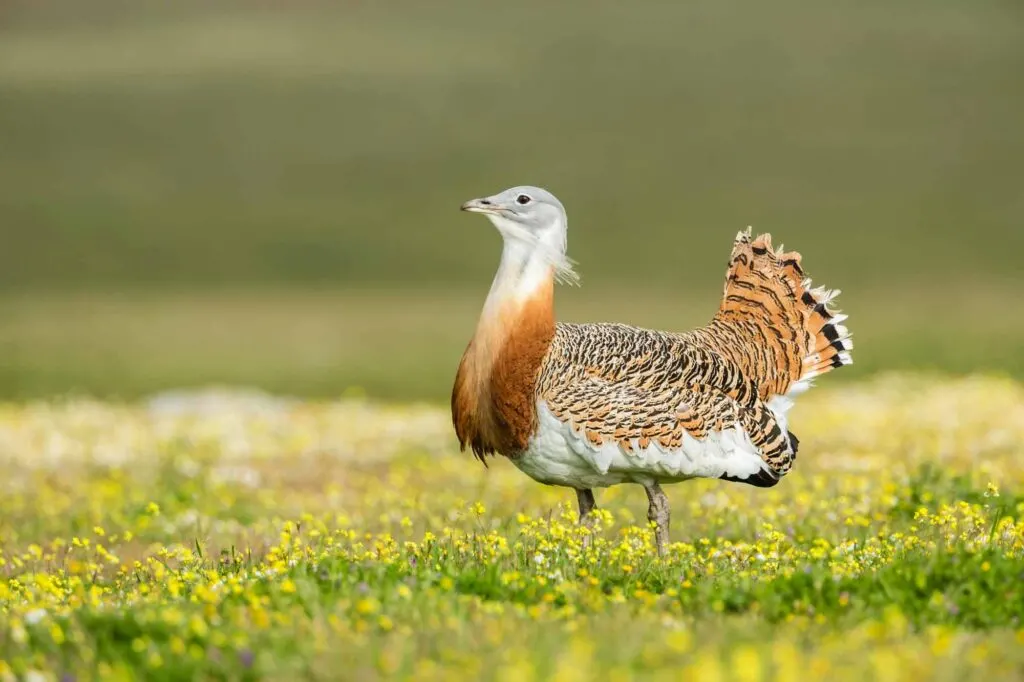
You’ll find these types of birds in grassland in Africa, southern Europe, Australia, Asia, and parts of New Guinea.
Bustards are medium – or large-sized birds between 16 to 59 inches long. They have long legs, three toes, and horizontal-like bodies.
They prefer to live on the ground and can run extremely fast when threatened, but they can fly sustainably, just slowly.
They have fascinating courtship movements where the male extends their neck back to the opposite end of the body with a puffed throat and fanned-out tail feathers.
Different species: There are 23 bustard species. The Great Bustard is the largest land bird in Europe.
Cuckoos (Cuculiformes)
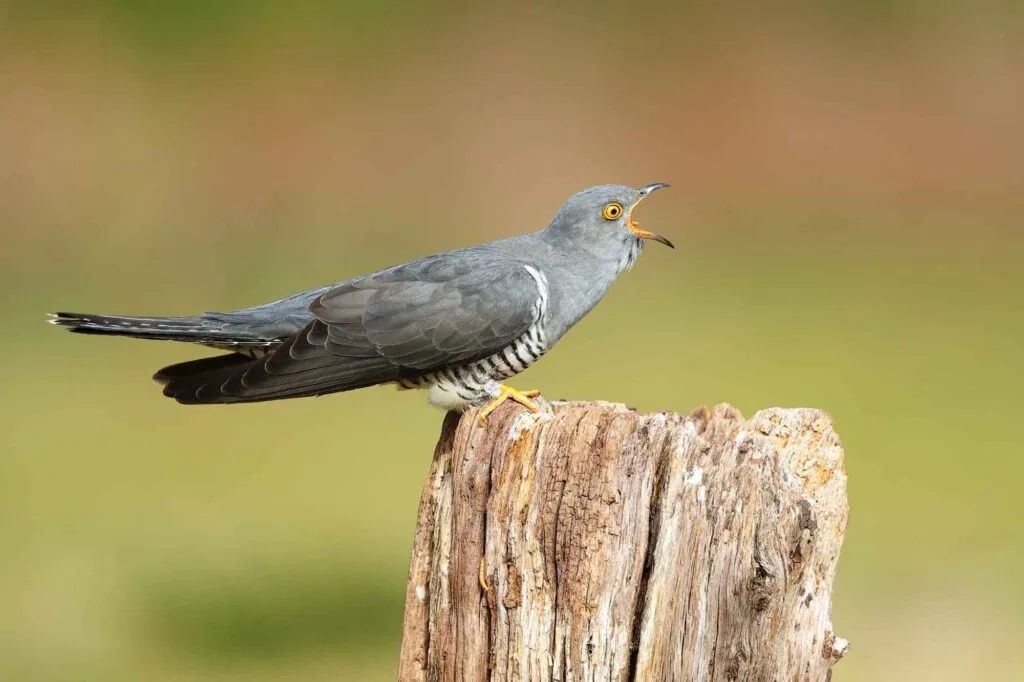
Cuckoos are not just the clock you might know about! These birds are smallish, but their looks vary as they’re found worldwide besides Antarctica.
They love to live in leafy trees in forests and thickets. These are the first carnivorous birds on this List of types of birds; some even eat frogs and baby birds of other bird species.
The common cuckoo found in Europe, Africa, and Asia is the one that makes the signature sound that led to the creation of German cuckoo clocks.
Male cuckoos also have a mating dance, which entails head bobbing and fanned feathers, to which females respond with a bubbling sound.
Different species: There are 147 cuckoo species. The common cuckoo, roadrunners, malkohas, koels, and coucals are the most known.
Turacos (Musophagiformes)
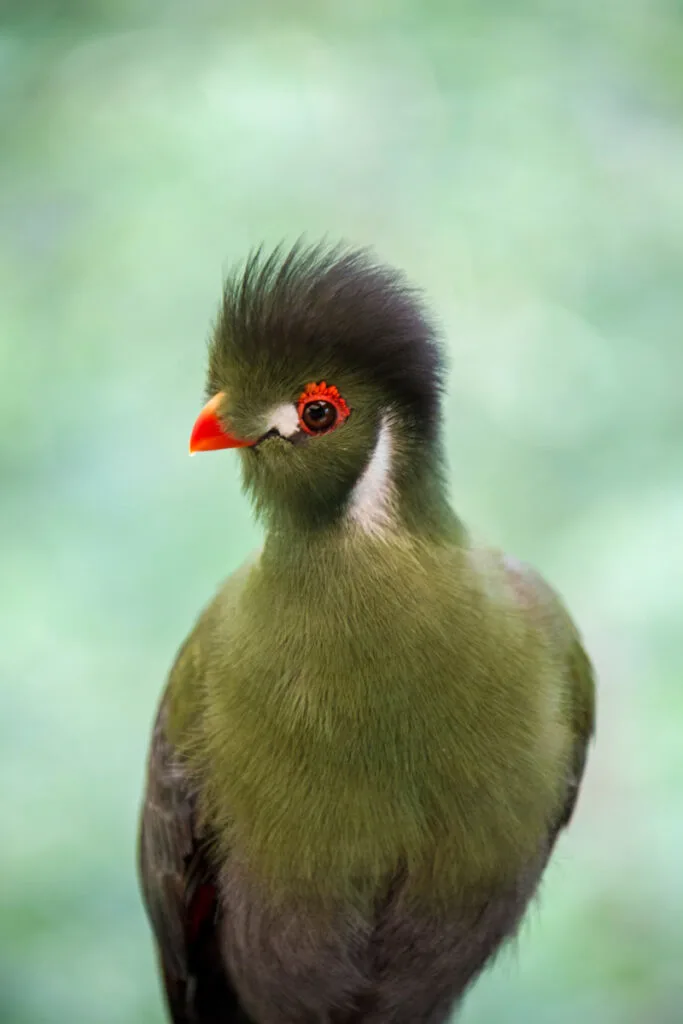
Turacos are lovely little birds that have bright colors like red or green, with some species being white, brown, or gray.
They inhabit parts of Africa where they are affectionately known as Loeries. They’re also sometimes called go-aways because of the “g’way” sound they make.
Turaco species vary in size from 4 inches to 28 inches. They are social birds that like to live in flocks and can live up to 30 years old.
Turacos live in woodlands and savannahs and love to live in trees, where they feast on fruit, flowers, and insects.
Different species: There are 18 turaco species, the most known being the white-crested turaco.
Rails And Cranes (Gruiformes)
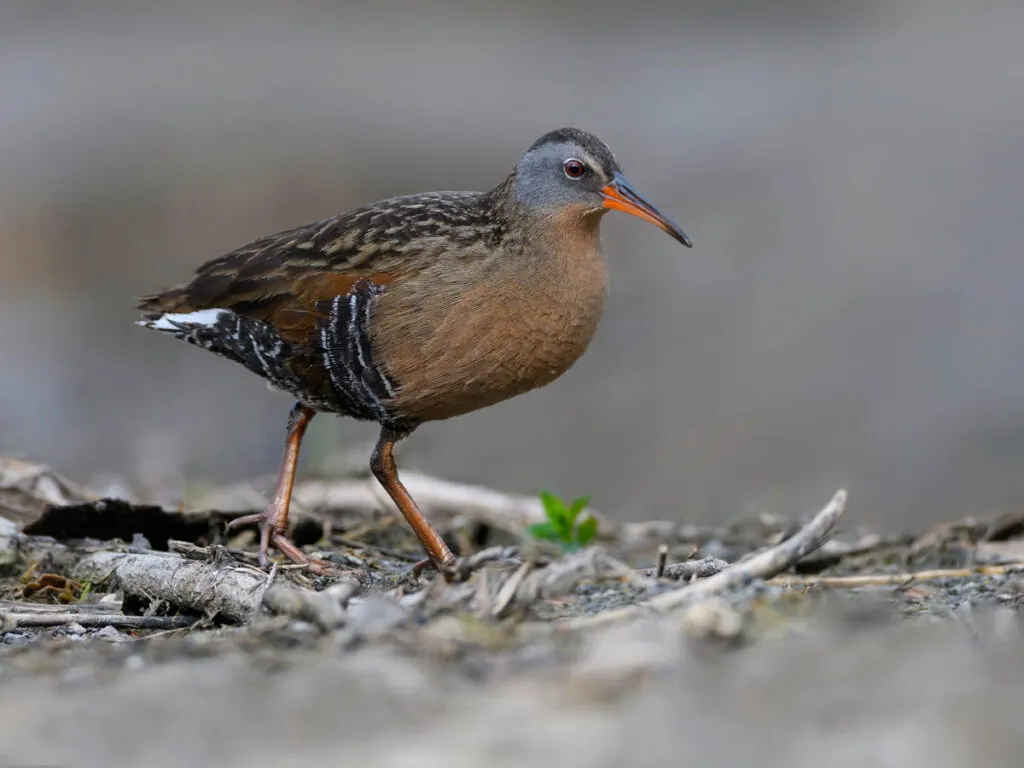
Rails, cranes, and their relatives are called Gruiformes. Rails are small or medium-sized, with species from 5 to 25 inches tall.
Cranes get up to 7 feet tall. The Sarus crane is the world’s tallest flying bird. Rails and cranes love to live in wetlands, marshlands, and forests.
Rails have short, rounded wings and like to live on the ground. Some rail species are entirely flightless, but they all find life easier to live on the land.
Cranes are tall birds with long legs, slender bodies, and large, rounded wings, and all can fly.
Different species: There are over 150 rails species and 15 crane species.
Waders And Relatives (Charadriiformes)
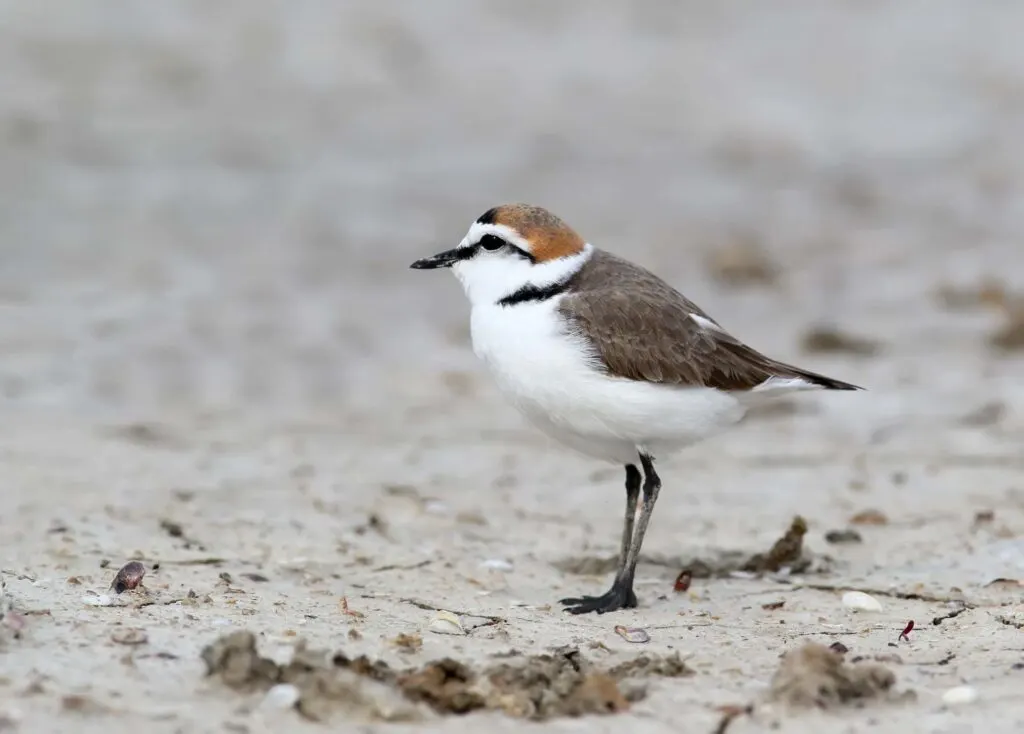
Waders are also known as shorebirds because they like to live on muddy shorelines like wetlands and coastal regions.
You can find waders on every continent. Some even like to live periodically in Arctic regions in the summer.
Most species like to eat invertebrates like insects and mollusks, depending on where they live.
They have sensitive beaks that help them find prey. Waders are known to migrate and have strong metabolisms for this purpose.
Different species: Waders have 210 species, not including herons and storks, which are also referred to as waders.
Hoatzin (Opisthocomiformes)
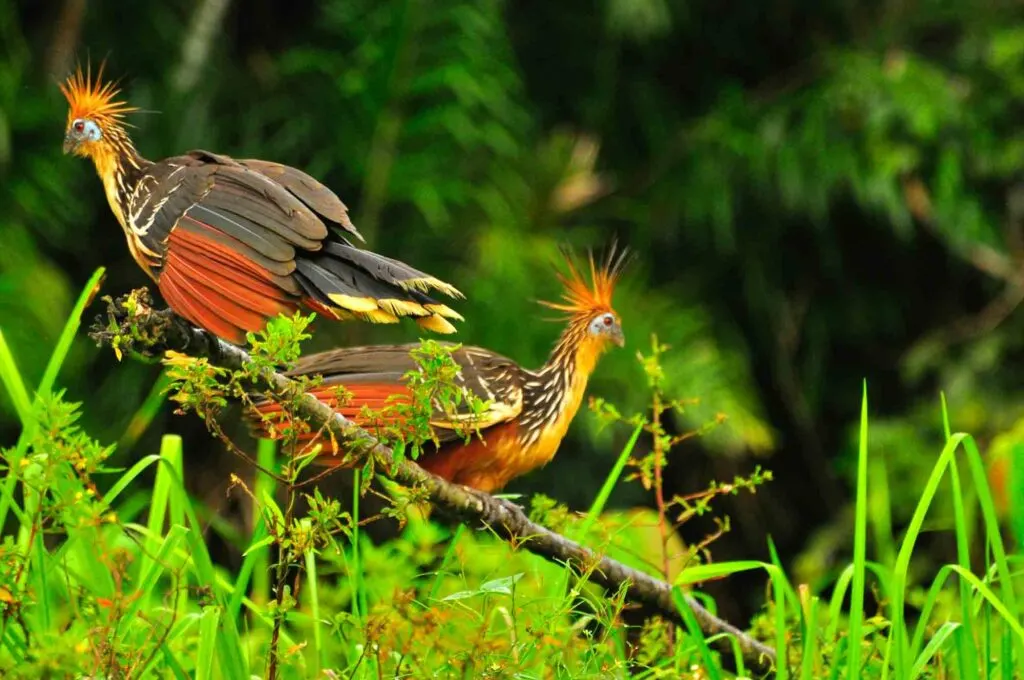
One of the most unique-looking types of birds is the hoatzin. They are the size of a chicken with an orange mohawk, blue face, and red wings.
They live in the Amazon basin along rivers and lakes, living in flocks.
They mainly eat leaves and have a different stomach from all other bird species because it has foregut digestive chambers like a cow instead of a regular stomach.
They live in branches and are good swimmers. They are clumsy creatures that make huffing noises when they walk.
Different species: Opisthocomus hoazin is the only species.
Nightjars (Caprimulgiformes)
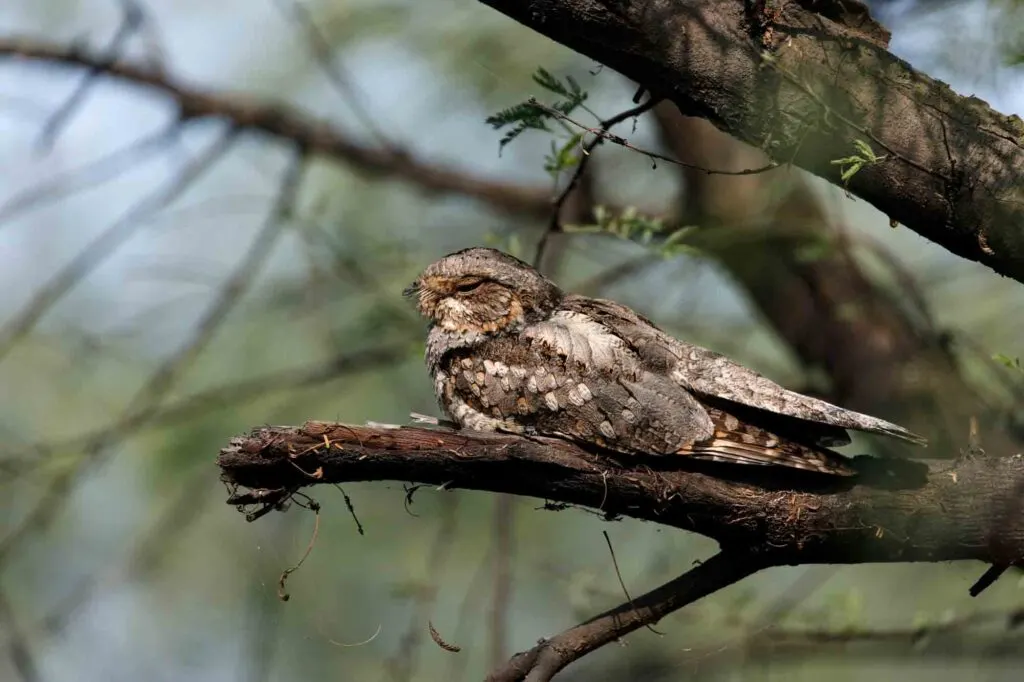
Nightjars are reddish brown, brown, or gray birds that have long wings, short legs, and very short beaks.
They grow between 12 and 28 inches long, depending on the species. They fly very quietly and disguise themselves easily along the bark of trees.
You can find nightjars in South America, Europe, Asia, and periodically in Africa. There is a legend that nightjars drink milk from goats and get called goatsuckers, but this isn’t true – they only feast on insects.
Nighthawks are also considered nightjars but have longer bills and softer feathers.
Different species: There are 79 nightjar and ten nighthawk species.
Potoos (Nyctibiiformes)
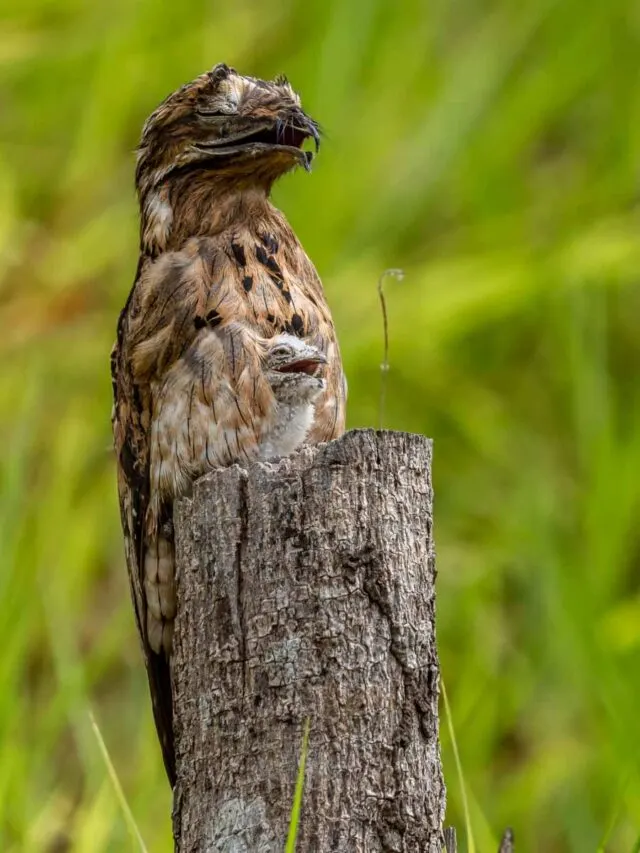
Potoos are related to frogjars, nightjars, and nighthawks. These weird birds make haunting sounds and live in Central and South America and Caribbean islands, finding sanctuary in forests.
They only eat insects, so you don’t have to worry about their eerie calls!
Potoo species look mostly the same with large heads, short beaks, big yellow eyes, long wings, and tails, and are brown.
They grow to be 8.3 to 22.8 inches long. One interesting fact is that potoos sense movement even when their eyes are closed to stay weary of predators!
Different species: Rufous potoo, Great potoo, Long-tailed potoo, Northern potoo, Common potoo, Andean potoo, and the White-winged potoo are some potoo species.
Oilbird (Steatornithiformes)
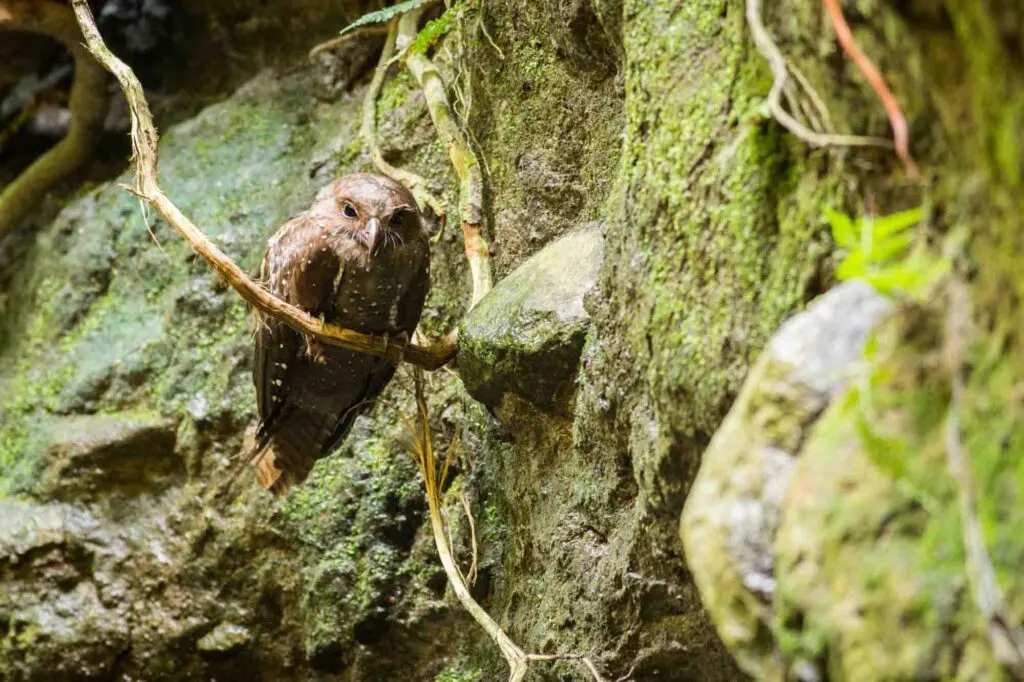
Oilbirds are found across South America, including Trinidad Island. Oilbirds are nocturnal creatures that eat fruit from laurels and oil palms – which is how they got their name.
They live in flocks and often nest in caves. Their eyesight is well-adjusted for nighttime foraging, and they have echolocation like bats.
These large birds grow between 16 and 19 inches and have a 37-inch wingspan. They have small eyes, hooked beaks, and soft reddish-brown feathers with white spots all over their body.
Their wings are unique in that they are easily twisted and help them hover for cave living.
Different species: The only oilbird species is Steatornis caripensis.
Frogmouths (Podargiformes)
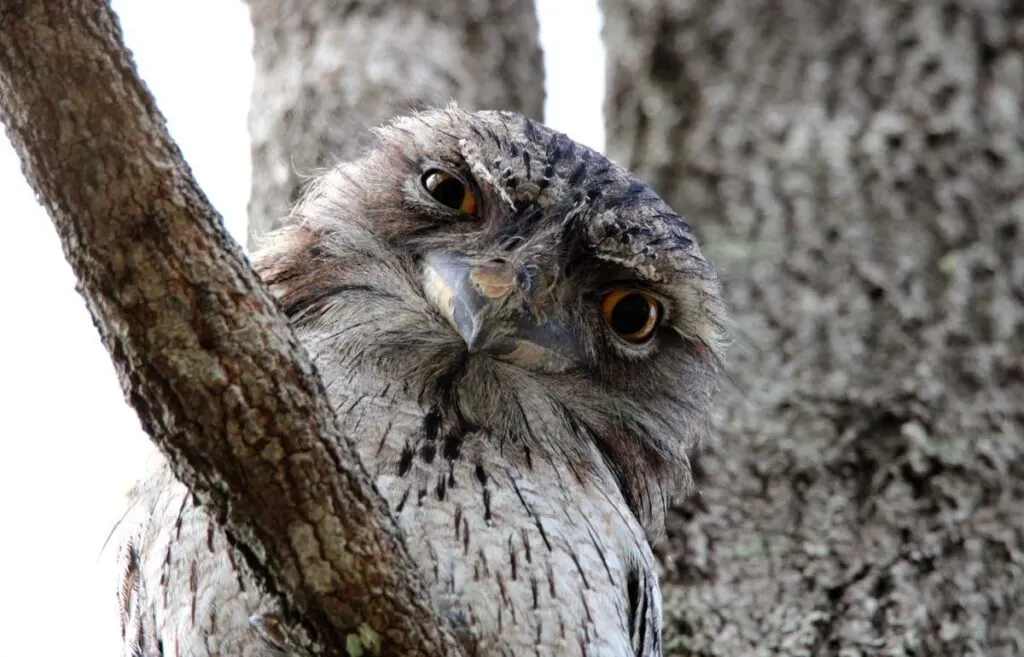
Frogmouths are found in southeastern Asia, Australia, and New Guinea. They are named after their frog-like beak, which they use to eat insects.
They have hooked beaks with bristles. Asian frogmouths have smaller, rounded beaks.
They are reddish-brown or grayish and disguise well by resting horizontally on branches. Frogmouths grow between 10 and 22 inches.
Frogmouths mainly eat insects but also prey on mice and tiny frogs, which they sometimes slam against rocks to help them capture their food.
The newest frogmouth species was discovered in 2007 in the Solomon Islands, starting a whole new Rigidipenna genus.
Different species: Frogmouth has 12 species, divided into the genus Podargus, Batrachostomus, and Rigidipenna.
Owlet-nightjars (Aegotheliformes)
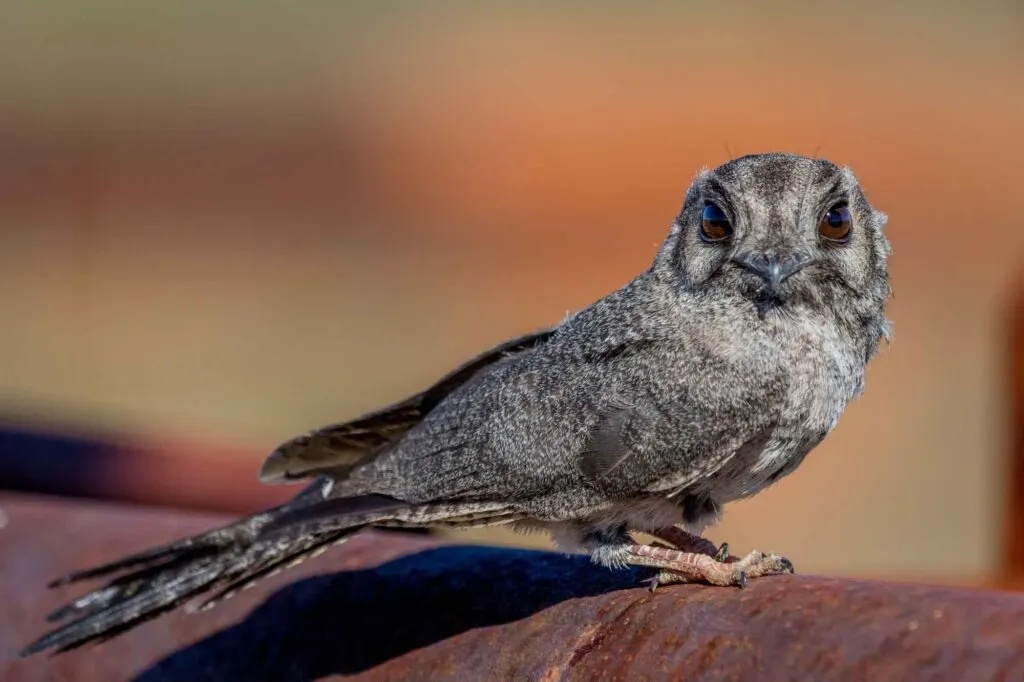
Owlet-nightjars are closely related to nightjars and frogmouths but are their own bird type.
These birds are only active in the twilight hours of the evening, known in zoology as crepuscular. Owlet-nightjars hunt insects midair and sometimes on the ground, too.
Most owlet-nightjars are found mainly in Australia, New Guinea, New Caledonia, and the Moluccas.
Their feathers are brown mixed with other pale shades, and they have short wings, long tails, tiny feet, and a small beak that can open wide for air hunting. They grow to 7 to 12 inches.
Different species: There are 11 species, and the best known is the moth owl.
Tropicbirds (Phaethontiformes)
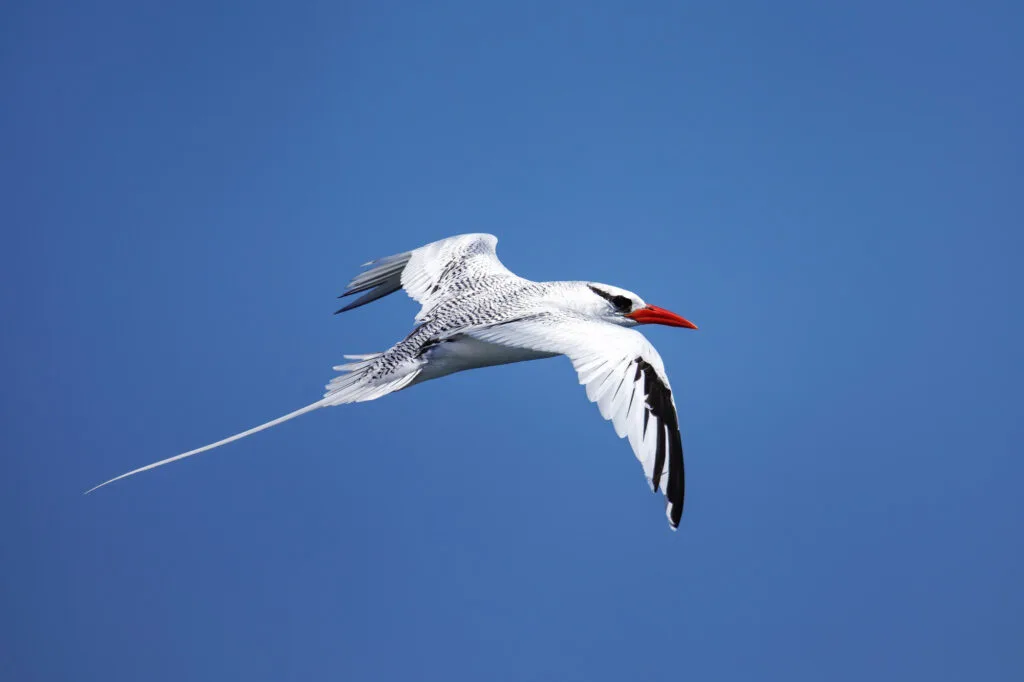
Tropicbird types are medium-sized animals ranging in size from 76 to 102 cm in length and 94 to 112cm in wingspan.
They are mostly white with varied black markings over their bodies.
Tropicbirds feed on squid and fish, catching their prey by plunge-diving into the ocean.
Further out, tropicbirds are seabirds native to the Atlantic, Indian, and Pacific oceans. Yes, they have a worldwide range.
Different species: There are three tropic bird species—red-billed, red-tailed, and white-tailed tropicbird.
Swifts, Treeswifts, and Hummingbirds (Apodiformes)
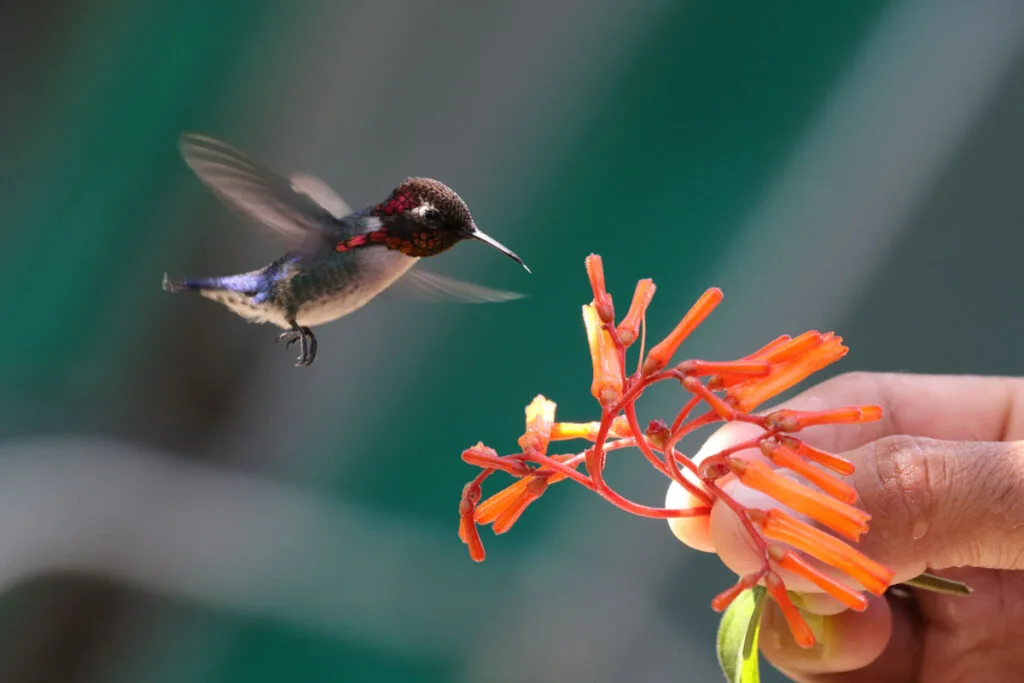
These three cute families of birds belong to the same order called Apodiformes because they share some anatomical similarities, such as long wings with short bones and bare feet.
Swifts are highly aerial birds. They are superficially similar to swallows but are not closely related to any passerine species. Also, they occur on all continents except Antarctica.
Treeswifts or crested swifts are aerial near passerine birds, closely related to true swifts. They are distributed from India and Southeast Asia through Indonesia to New Guinea and the Solomon Islands.
All the different types of hummingbirds are native to the Americas and have varied specialized characteristics to enable rapid, maneuverable flight, exceptional metabolic capacity, adaptations to high altitudes, sensitive visual and communication abilities, and long-distance migration in some species.
Different species: there are around 100 swift, four treeswift, and 366 hummingbird species in the world. Some are the dark-rumped swift, volcano hummingbird, and mustached treeswift.
Sunbittern And Kagu (Eurypygiformes)

Sunbitterns are found in tropical North and South American regions. They have similarities to the kagu but are entirely their bird type.
Sunbitterns are neutral-colored with linear patterns and have long, pointed beaks. They use vivid wing patterns to display courtship and scare off threats.
Kagus are highly endangered, nearly flightless birds only located in New Caledonia. They are gray, with a large rump, orange eyes, reddish-brown beaks, and legs. They grow up to 22 inches.
Like Sunbitterns, they display their feathers in the presence of threats and courtship.
Different species: Sunbitterns have three species: The Amazonian sunbittern, the northern sunbittern, and the foothill sunbittern. The only Kagu is Rhynochetos jubatus.
Loons (Gaviiformes)
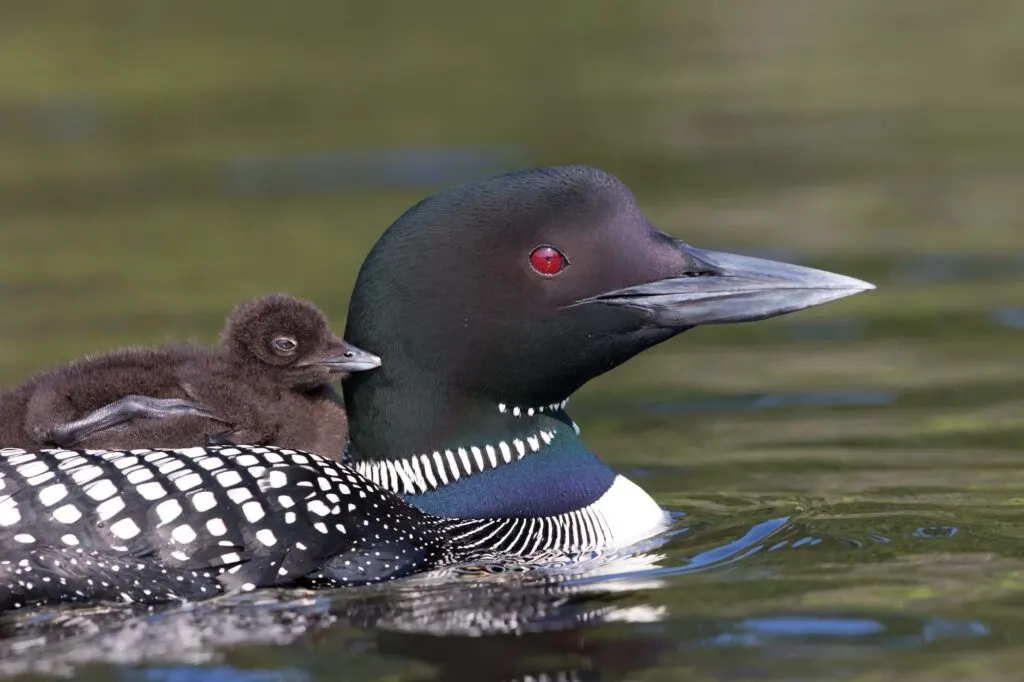
Loons, also known as divers, are found in North America and northern Eurasia.
They are black and white with gray spear-shaped beaks, and all species look similar, making them hard to distinguish.
They look like ducks and spend their time in water propelled by their webbed feet.
They used to be classified as grebes only because they looked similar. These aquatic creatures can dive 200 feet below water and compress air to support their underwater adventures.
They eat fish, crabs, and insects. Their haunting calling sounds give them their name, which means ‘to moan’ in Old Norse.
Different species: Common loon, juvenile red-throated loon, black-throated loon, yellow-billed loon, and the Pacific loon.
Albatrosses And Petrels (Procellariiformes)
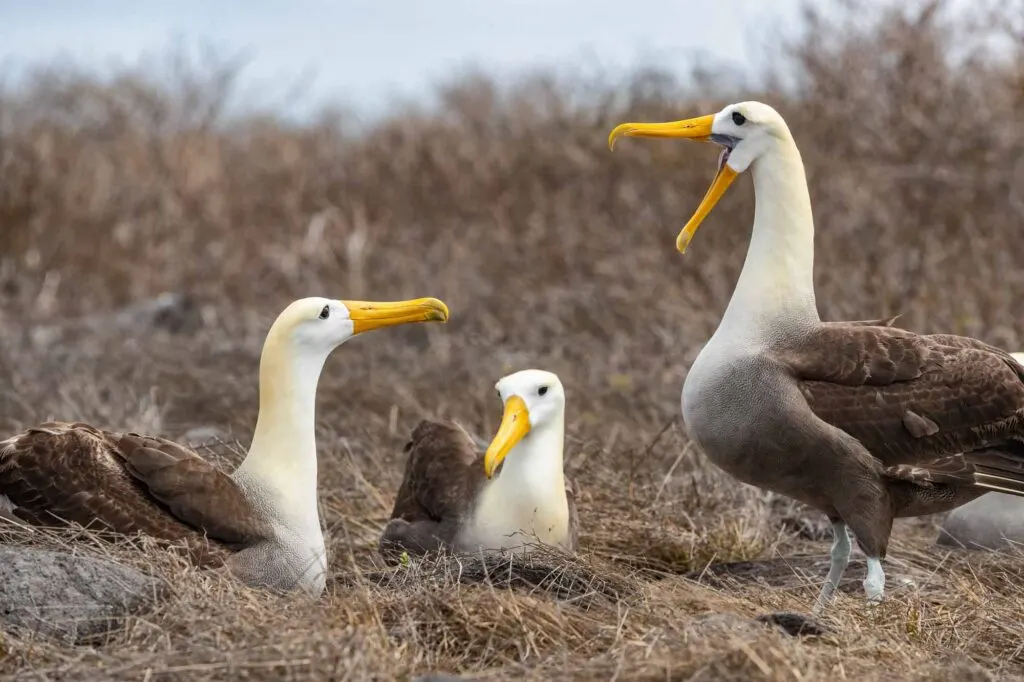
Albatrosses are seabirds found around the Southern and Pacific oceans. They’re one of the largest flying birds and have a 12-foot wingspan.
They drink seawater and eat squid, krill, and fish. They struggle to keep their heavy bodies airborne, so they spend much time floating around.
Sailors say it is bad luck to kill an Albatross.
Petrels are closely albatross-related seabirds adapted to live in cold conditions, like the snow petrel.
They nest inland and on cliffs and meat fish and krill. The snow petrel is one of the only three birds in the Antarctic region, followed by the Antarctic petrel. Most petrel species are white with black eyes.
Different species: There are 22 albatross species and seven petrel species.
Penguins (Sphenisciformes)
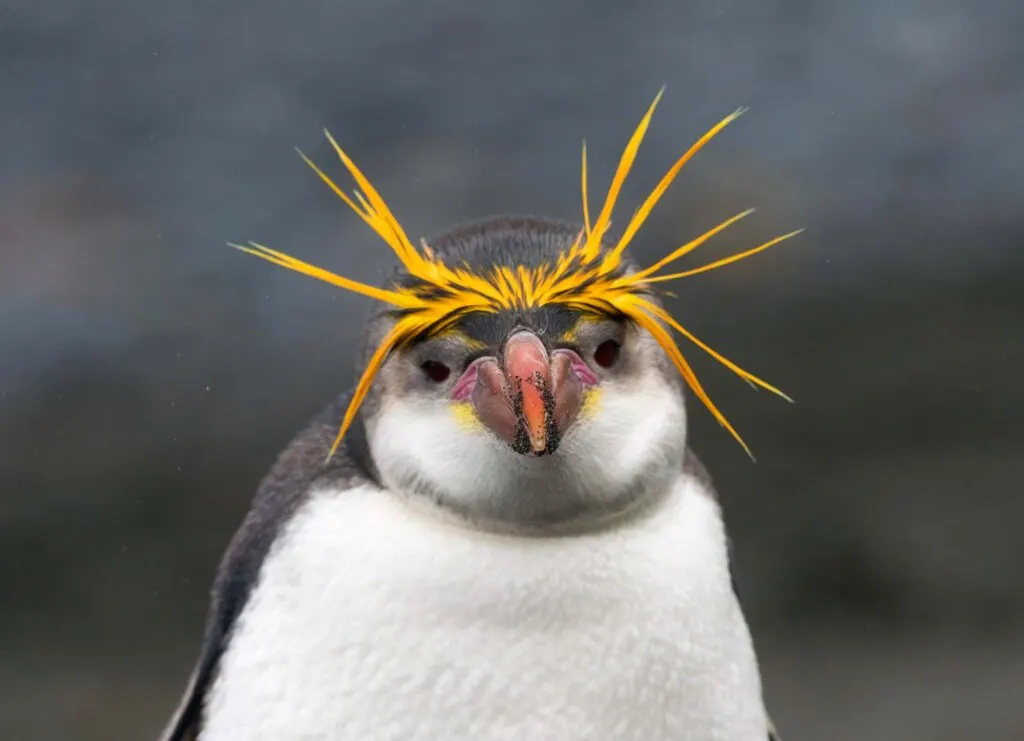
A penguin is a flightless bird specially adapted to a marine lifestyle. Their wings are modified flippers, and they are excellent swimmers.
There are six penguin genera and roughly 19 penguin species; however, scientists often argue over which subspecies should be a species themselves. Added together, we have (roughly) 278 different types of penguins.
The six penguin genera are Aptenodytes, Eudyptes, Eudyptula, Megadyptes, Pygoscelis, and Spheniscus.
Different species: king penguin, chinstrap penguin, Adelie penguin, and emperor penguin (biggest species of penguin).
Storks (Ciconiiformes)
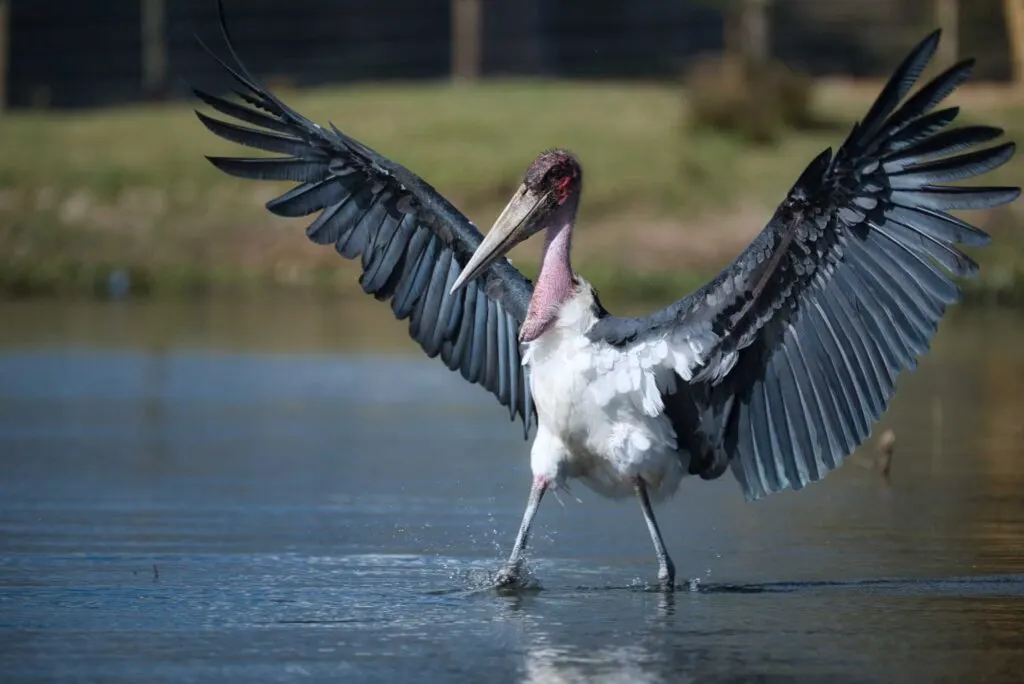
Storks are birds that are rumored to carry babies to their mothers! These birds are found along shorelines of Africa, Asia, and Europe.
Some newer species are found in Argentina and Australia. They grow between 2 to 5 feet tall, have long bills, legs, and necks, and vary in color but are mostly known to be white.
They aren’t very vocal because they have an underdeveloped voice organ, but instead clatter their beaks to communicate, especially when they’re excited.
They live in flocks and eat during the day on a diet of fish, small creatures, and sometimes carrion.
Different species: There are 19 stork species. The most commonly known are the white stork and saddle-billed stork.
Boobies And Cormorants (Suliformes)
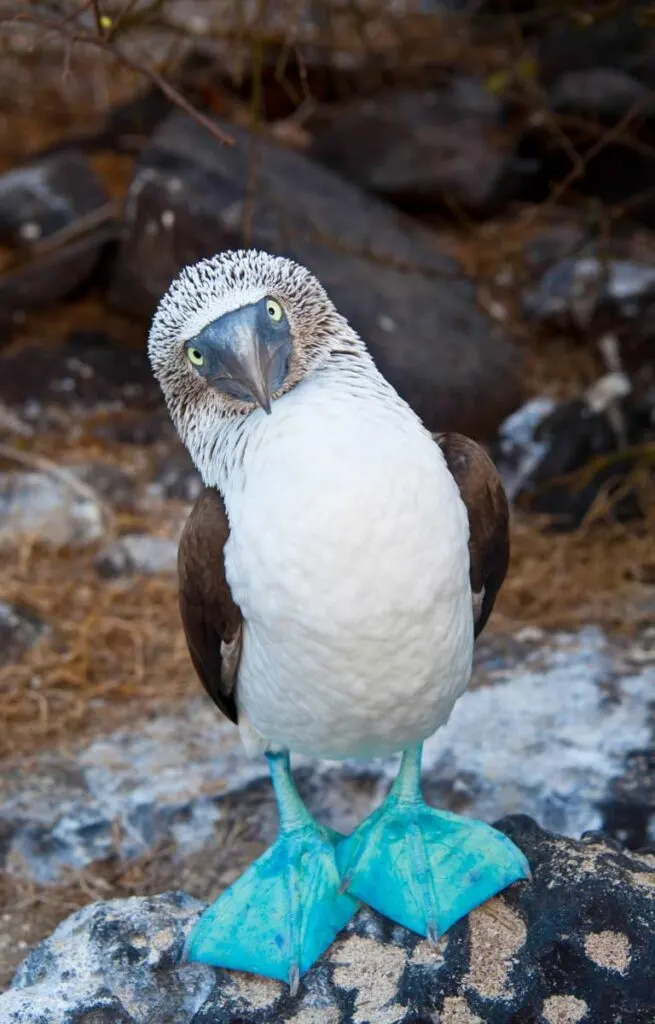
Another seabird is a booby. Boobies are up to 35 inches long and have long beaks with stout bodies.
They live by the sea and have a diet of fish, which they dive out from the water. They have air sacs to help alleviate pressure when they dive.
They are sadly an endangered species, thought to be caused by overfishing.
Cormorants are seabirds found in Britain and Ireland. They are 24 to 39 inches long with dark-colored feathers, thin beaks, and webbed feet.
They can dive 150 feet deep into the oceans they live around and only eat fish.
Different species: Boobies have six species, including the commonly known blue-footed boob, and the only cormorants are the great cormorant and the common shag.
Pelicans, Herons, And Ibises (Pelecaniformes)
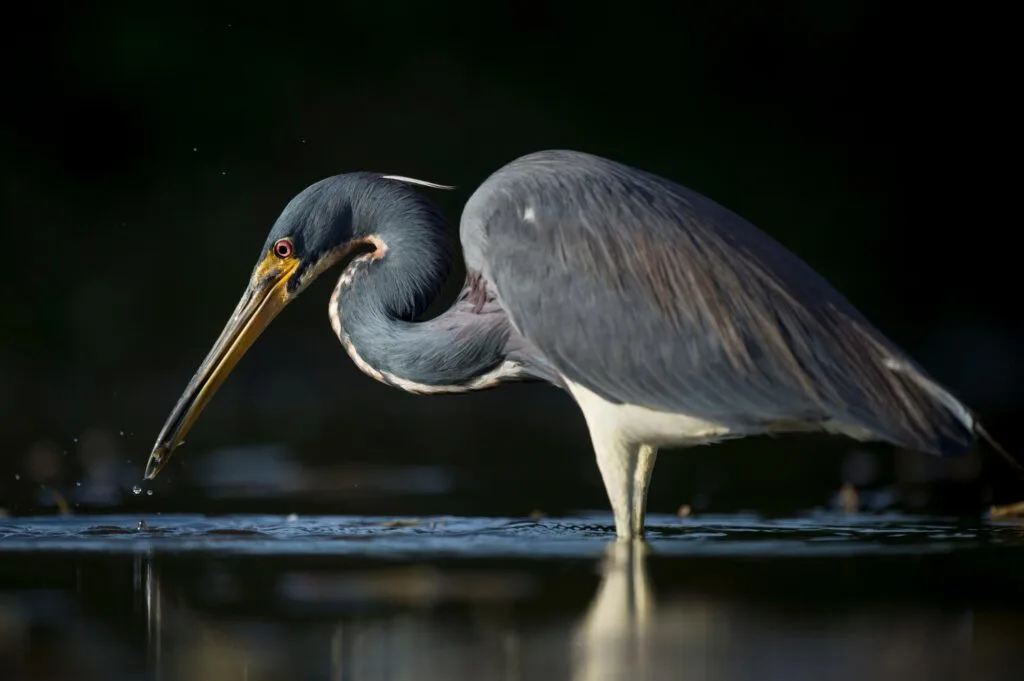
Pelicans are large water-loving birds that grow to 70 inches with a 10-foot wingspan.
They are most known for the pouch beneath their beak, which is used to capture prey and drain water – they surprisingly don’t use their pocket to save food for a later snack!
Herons are found around wetlands, marshlands, and rivers in many parts of the world.
They eat frogs, fish, and any other aquatic creatures they encounter. Herons stand in an s-shape with an elongated neck, thin lengthy pointed beak, and extended legs.
Ibises live in wetlands, forests, and plains in warm regions, feeding on fish and mollusks.
They grow to 30 inches long, have thin bodies, long necks, and extended pointed beaks, and vary from brown to white depending on the species.
Different species: Pelicans have seven species, herons have 60, and ibises have 29.
New World Vultures (Cathartiformes)
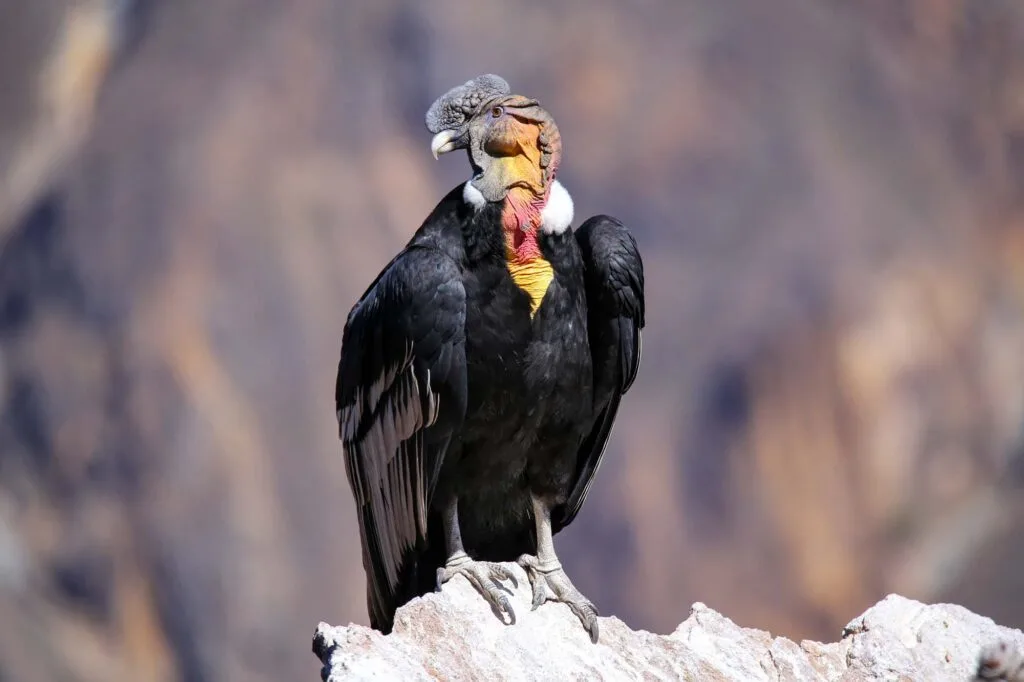
New World vultures belong to the order Cathartiformes of raptors or birds of prey, which has seven species.
Vultures are like nature’s clean-up crew! They’re scavenging birds that love to feast on the bodies of dead animals.
Surprisingly, eating this kind of food doesn’t make them sick at all. In fact, their tummies are home to special bacteria that help them digest the meat.
Also, New World vultures have a great sense of smell, so they can sniff out their next meal.
One thing you might notice about vultures is that they have bald heads. Yep, that’s right – no feathers on their heads! It might look a bit strange, but it actually serves a purpose. Feathers can get messy when they’re eating, so having a bald head helps keep them clean.
Overall, vultures play an essential role in nature, making sure that nothing goes to waste and keeping our environment tidy. They’re fascinating types of birds, don’t you think?
Different species: turkey vulture, Andean condor, king vulture, and California condor.
Hawks And Relatives (Accipitriformes)
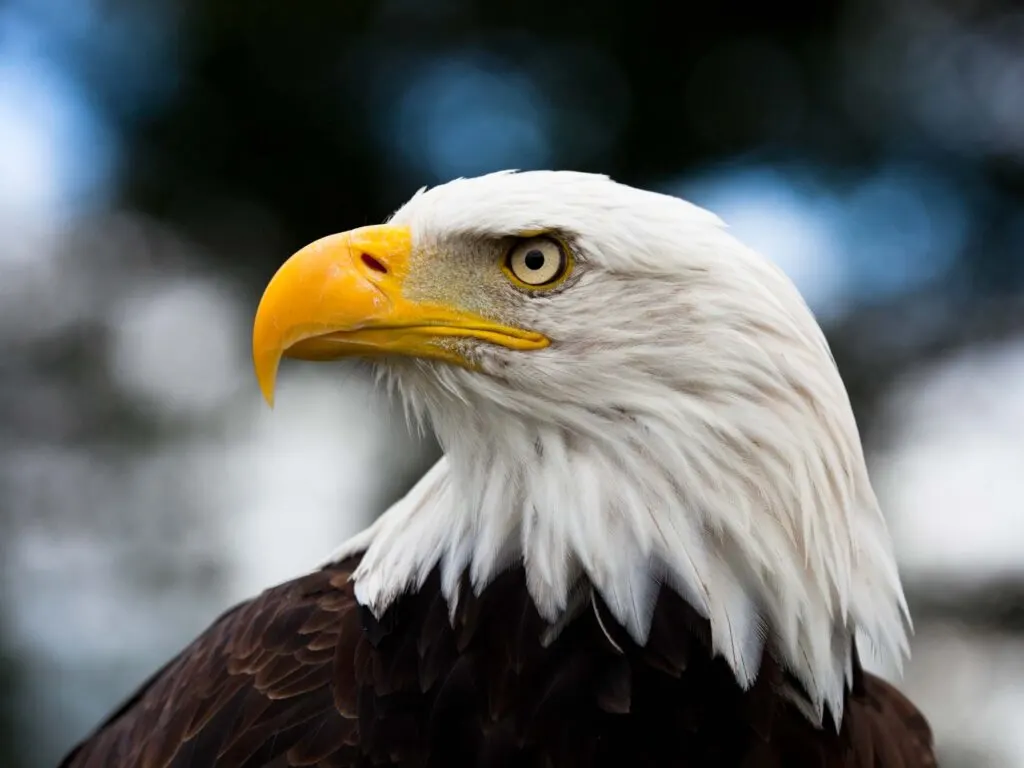
Hawks, eagles, Old World vultures, and kites are all diurnal birds of prey belonging to the Accipitriformes order.
Hawks are types of birds of prey in the Accipitriformes order that vary from small to medium-sized.
With keen eyesight, hawks are able to see eight times clearer than humans and in color.
Most hawks are robust raptors that have a range of 18 to 30 inches in size and often prefer living in large, open spaces of North and Central America, the West Indies, and Jamaica. But they can be found in most continents except Antarctica.
Different types of hawks keep a diet consisting of small mammals, reptiles, and some seafood caught frolicking in shallow waters like crabs.
As for eagles, they are powerfully-built birds of prey with sturdy heads and beaks. Most of them live in Africa and Eurasia, but some can be found in the Americas and Australia.
There are about 68 different types of eagles in the world, and they are divided into subfamilies according to their DNA: fish eagles, booted eagles, snake eagles, and harpy eagles.
A vulture is a bird that loves to feast on dead animals. There are 23 types of vultures alive today (including Condors).
The Old World vultures are found in Europe, Africa, and Asia, and there are 16 different species of them. These types of birds are amazing scavengers!
Another relative of hawks, the kites, are birds of prey that belong to the Accipitridae family. They come in many types, with three main groups: Milvinae, Elaninae, and Perninae.
Kites are usually smaller than the other birds in this order and have a small head, a partly bare face, a short beak, and long, narrow wings and tail.
These cool birds can be found all around the world, but they mostly live in warm regions. Some kites like to eat insects, while others are scavengers and enjoy munching on rodents and reptiles. There are even a few kites that are specialists in eating snails!
Different species: Ferruginous hawk, northern goshawk, common black hawk, cinereous vulture, griffon vulture, black-winged kite, and bald eagle (the most famous North American bird species).
Owls (Strigiformes)
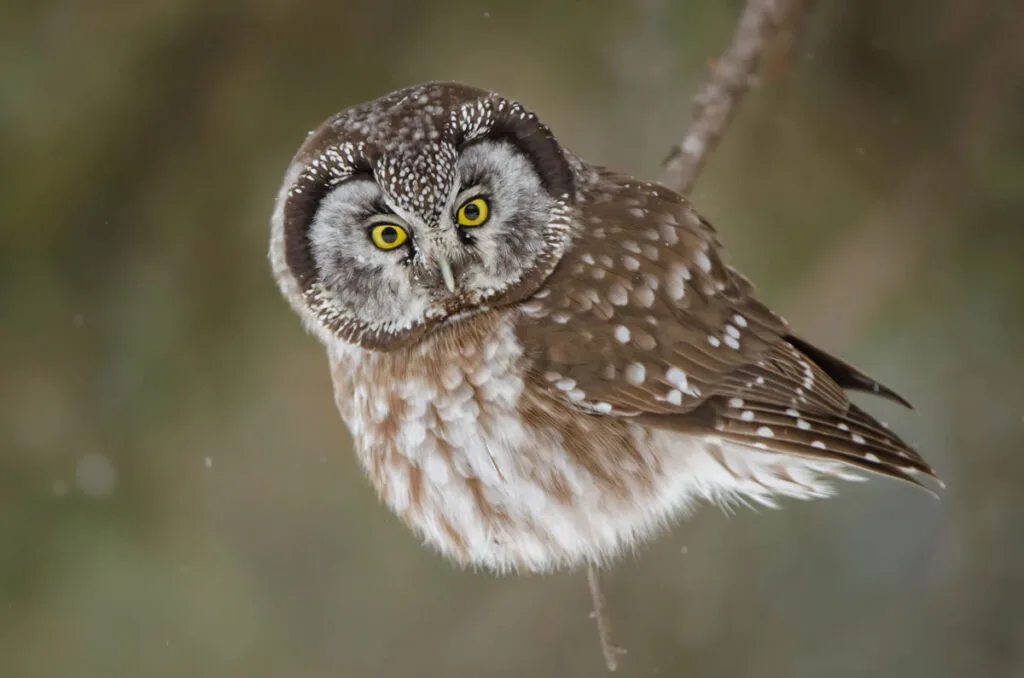
Regardless of the types of owls in question, most owls have a distinct and similar physical appearance.
The round, facial disk face helps them focus sounds toward their large, feathered ears.
Most owls have asymmetrically positioned ears that help triangulate the prey’s position from the littlest sounds.
As with most owls’ characteristics, the fluffy feathers help owls make virtually no noise when flying through the night sky.
The stealthy feathers pair incredibly well with the owl’s large, bulbous forward-facing eyes to create a deadly predator.
Owls are scientifically classified as raptors, birds of prey, and are referred to as Strigiformes. This Strigiformes order is split into two main types of owls: Tytonidae and Strigidae.
Owls hunt mostly small mammals, insects, and other birds, although a few species specialize in hunting fish.
Different species: tawny owl, Eurasian eagle-owl, Tasmanian masked owl, and barn owl
Mousebirds (Coliiformes)
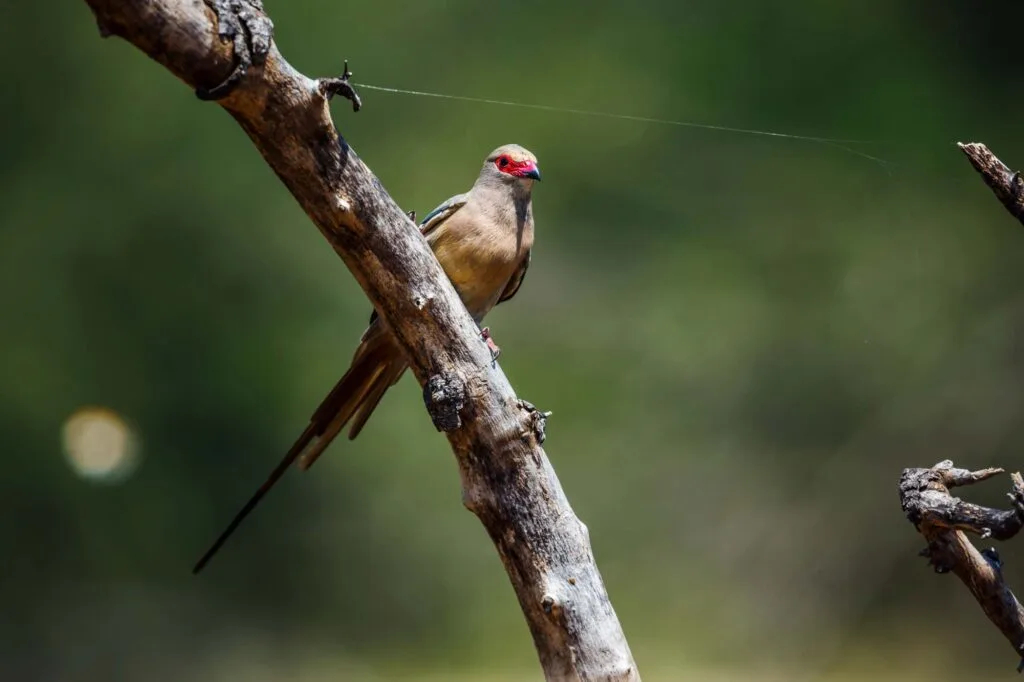
If you travel to sub-Saharan Africa, you’ll find the little mousebird fluttering in the trees. They are the only Africa-only bird.
They have a 3.9-inch body length, long, thin tails that extend to 9.4 inches, stubby beaks, and grayish. Their feathers look like hair, which makes them look like mice, giving them their name.
They live in flocks and eat seeds, berries, and budding flowers. Their strong claws grip well enough that they sometimes feed upside down!
They scurry around with their short legs and are incredibly acrobatic, which makes them fun to watch.
Different species: The six remaining species are the red-faced mousebird, speckled mousebird, white-backed mousebird, red-backed mousebird, white-headed mousebird, and blue-naped mousebird.
Cuckoo Roller (Leptosomiformes)
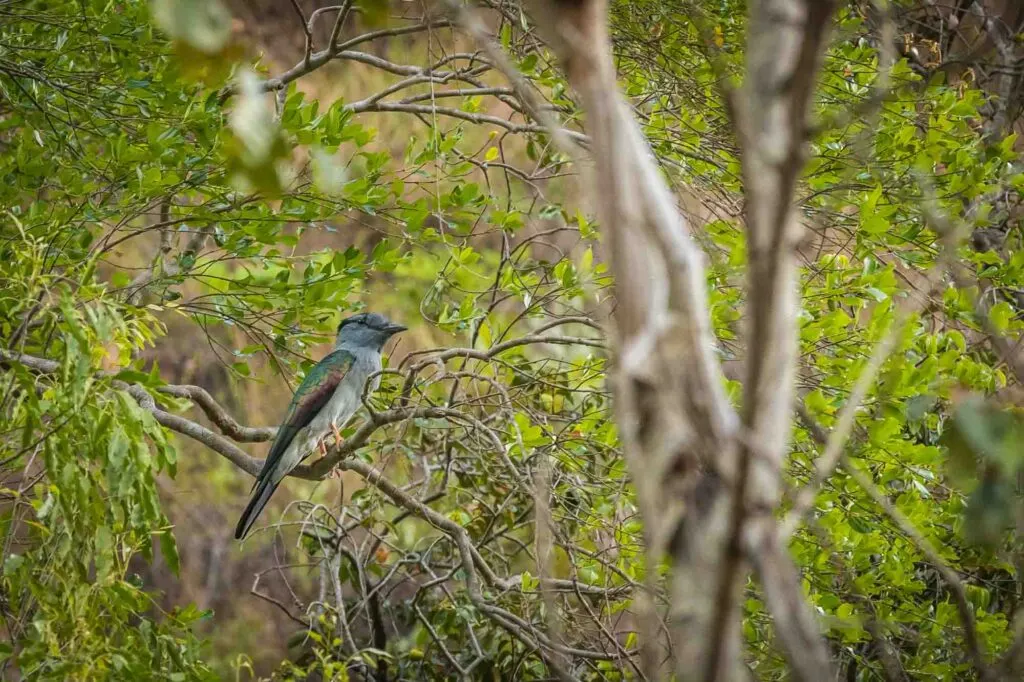
The cuckoo roller is its very own species that is not related to the cuckoo itself. Cuckoo rollers inhabit forests and woodlands in the Comoro Islands and Madagascar.
They grow between 16 to 20 inches, have gray chests and heads, greenish wings and tails, spotting, stout beaks, and only two toes.
These birds sit perched, waiting for prey, including insects like caterpillars and grasshoppers, and sometimes, they eat chameleons and geckos.
Cuckoo rollers nest high up in trees and are thought to live in pairs.
Different species: The only species is Leptosomus discolor.
Trogons And Quetzals (Trogoniformes)
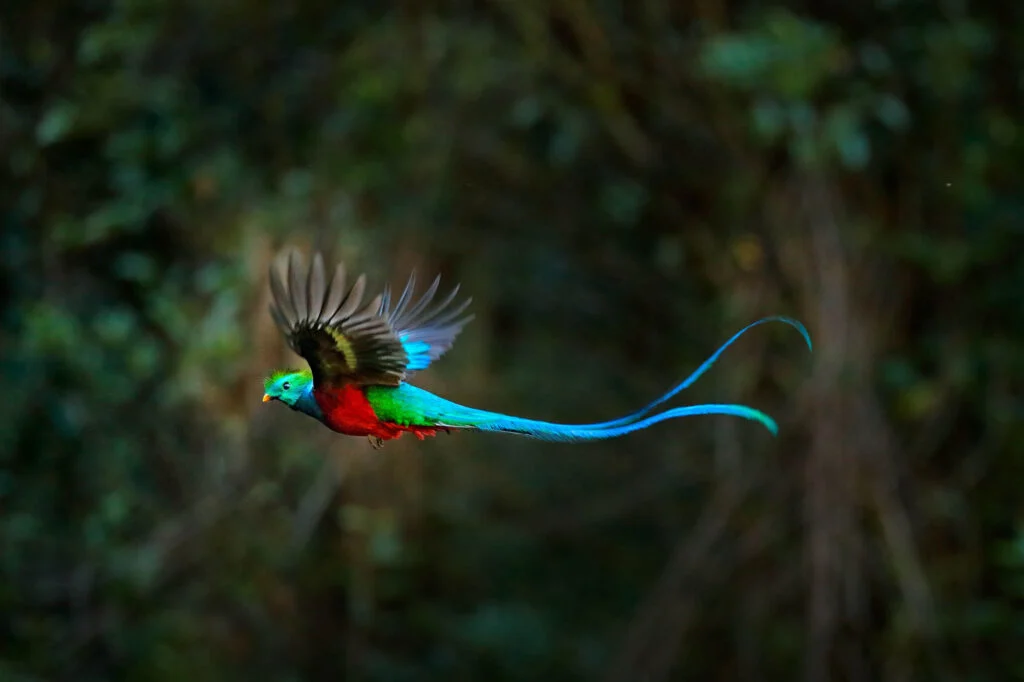
Trogons and quetzals are of the same taxonomic order Trogoniformes. They are colorful and are between 9.1 and 16 inches long.
Trogons have fossils that date to 46 million years ago, meaning these birds know how to survive! They nibble holes in trees to nest in tropical forests across the world.
Quetzals are also colorful birds with similar habits to trogons but are found in Mexico and Central and South America.
They are also larger than average trogon species, reaching 13 to 16 inches long, with tails that can double this measurement.
Different species: Trogonidae has 46 species, 5 of which are quetzals.
Hornbills And Relatives (Bucerotiformes)
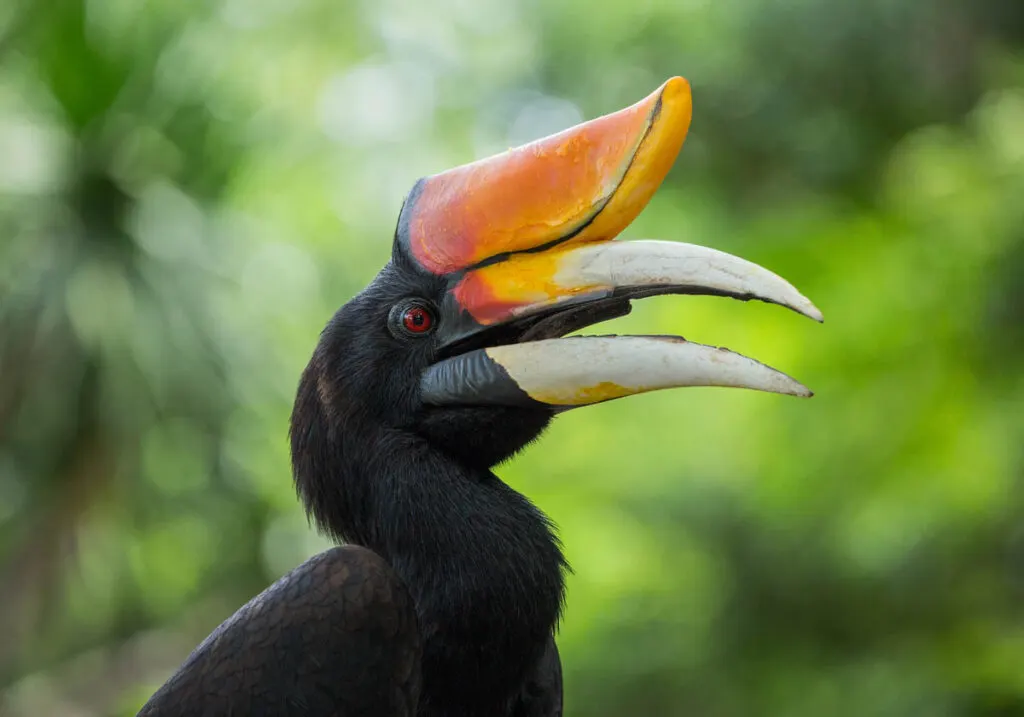
Hornbills are one of the bird types in tropical regions of Africa, Asia, and some nearby islands like New Guinea.
Hornbills are named after their large, curved beak that sometimes has a casque in some species.
Hornbills are usually black with white or colored markings and an orange or yellow bill.
These types of birds have smaller species that grow to 1 foot long and larger ground species that reach 4 feet 11 inches.
Hornbills use their powerful beaks to catch prey, fight, and build nests. They eat fruit, insects, and small animals.
Different species: There are around 60 hornbill species.
Kingfishers And Relatives (Coraciiformes)
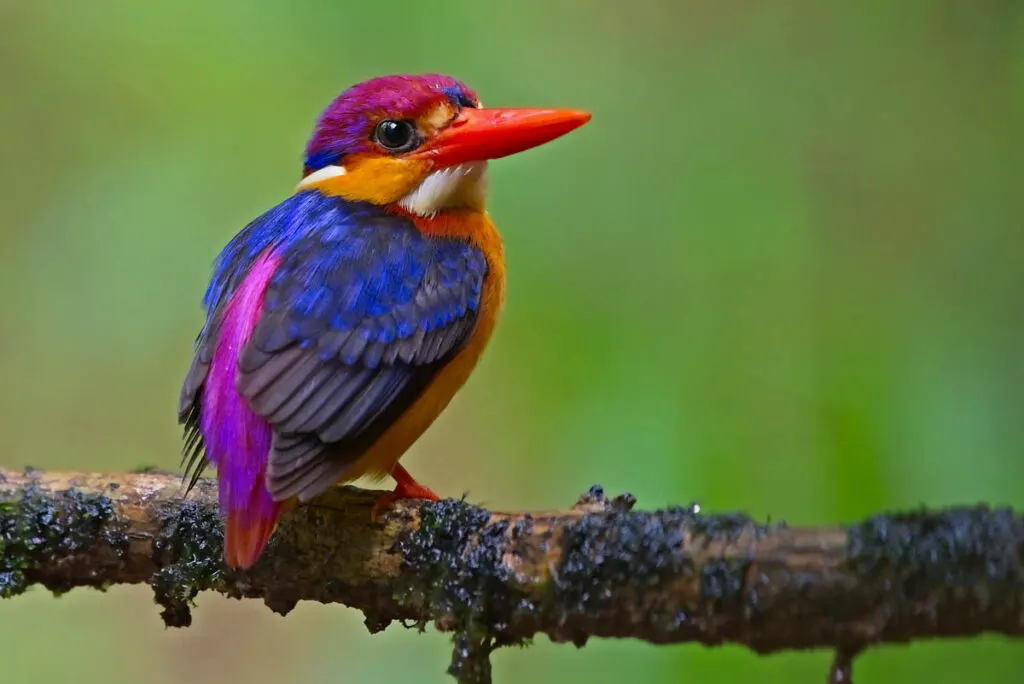
Kingfishers are brightly colored birds in Africa, Asia, Oceania, and Europe.
Colorful plumage, brown eyes, pointed beaks, and short, broad bodies characterize kingfishers. Depending on the species, they grow between 3.9 and 18 inches long.
They prefer a tropical habitat near water to fish but also eat insects, worms, reptiles, frogs, and other small creatures.
These types of birds are territorial creatures and have a monogamous mating pattern.
Different species: Kingfishers have 116 species divided into river, water, and tree varieties.
Woodpeckers And Relatives (Piciformes)
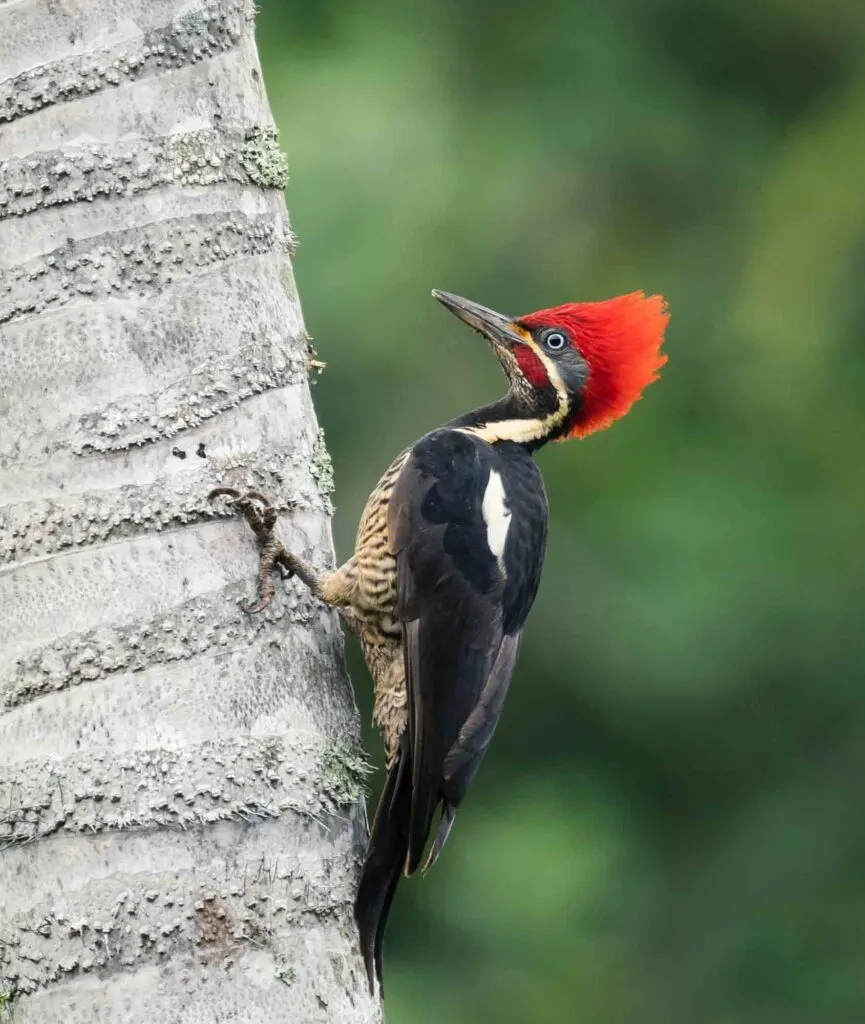
Woodpeckers live in woodlands and forests worldwide, besides the Gila woodpecker, which nests in cacti!
Smaller woodpeckers are 3 inches long, and larger species of bird grow to 22 inches.
Some are colorful, while others are dull, but all woodpeckers are known to use their sharp beaks to knock into the wood to find prey, make nests, and communicate.
Woodpeckers have strong legs and claws to help them live their lives moving around trees.
Their brains are also specialized to allow them to peck wood without damage. Piculets and wrynecks are woodpecker relatives.
Different species: There are around 240 woodpecker species, including northern flicker, Gila woodpecker, and great slaty woodpecker.
Seriemas (Cariamiformes)
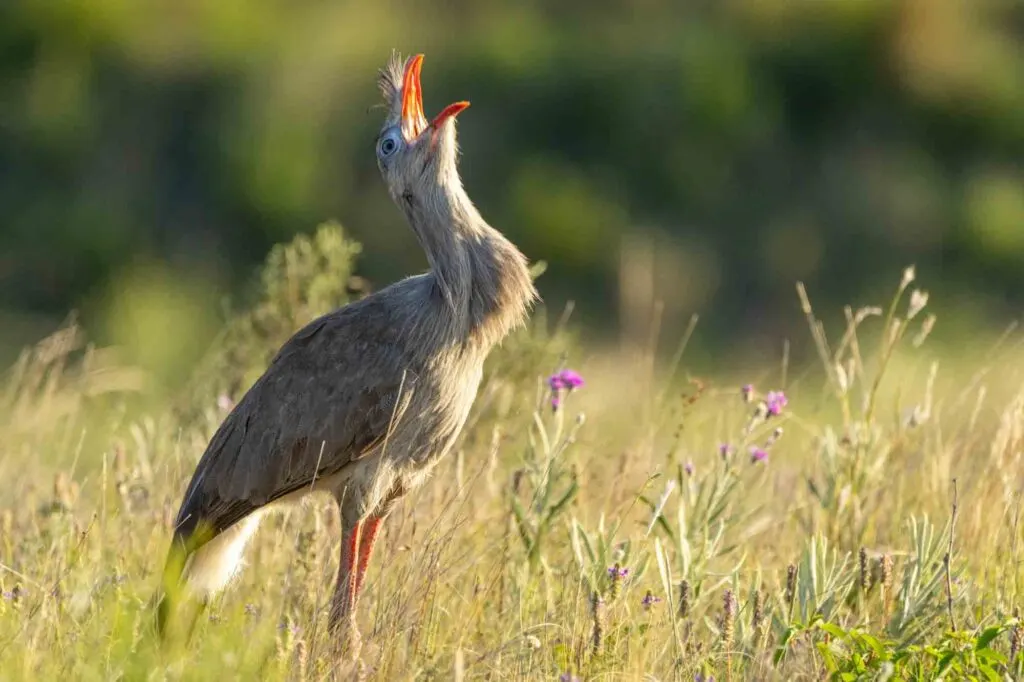
Seriemas are the only remaining species of the family of birds called Cariamidae. These kinds of birds were once believed to belong to the crane family because of their appearance.
They have long legs and necks, short wings, hooked bills, and brownish feathers. They grow up to 35 inches tall and weigh around 3.5 pounds.
Seriemas prefer to remain on the ground to find food, following a diet of insects, frogs, snakes, lizards, and some plants, and nest in trees at night.
They either live alone or in pairs and never migrate. Although they can fly, they’re better at running, reaching speeds of 37 miles an hour.
Different species: There are only red-legged and black-legged Seriemas.
Falcons (Falconiformes)
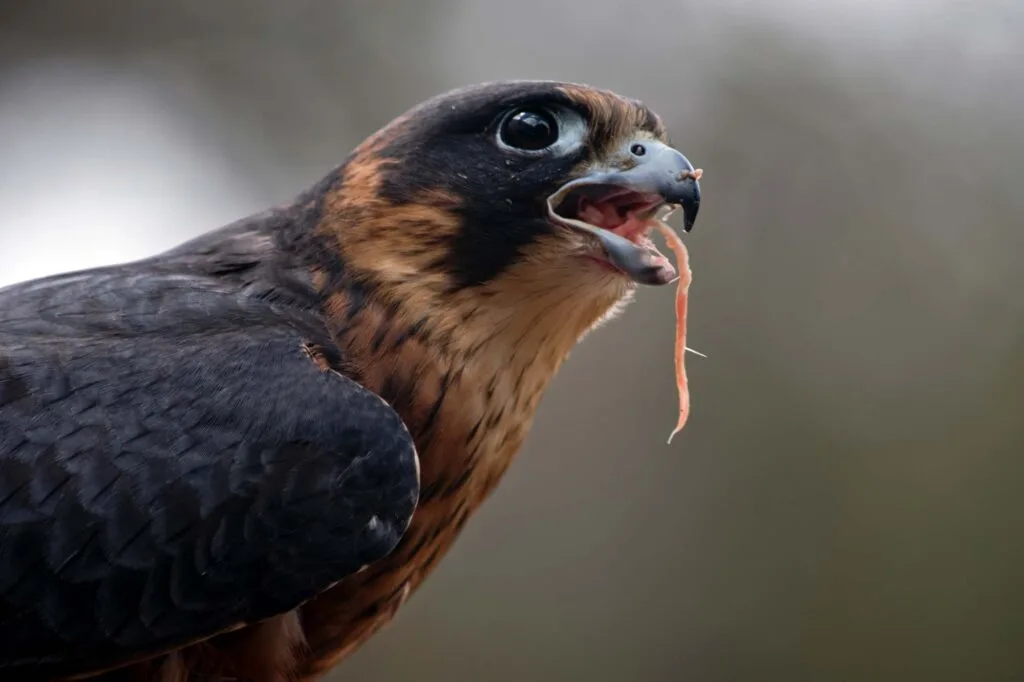
Falcons are highly specialized carnivores that actively hunt for prey, which include reptiles, rodents, insects, smaller types of birds, and small vertebrates.
They are the largest genus in the family, Falconidae.
Falcons differ from other raptors like hawks and eagles as they have a specialized beak equipped with a tomial tooth specifically used to kill prey. Eagles and hawks usually kill using their strong feet before ripping prey apart.
Also, they have thin, tapered wings that allow these types of birds to fly and quickly maneuver at high speed.
The group of birds referred to as falcons live solitary lifestyles. They are diurnal birds, which means that they hunt during the day.
A notable feature of falcons is that they take the honor of being the fastest creatures on Earth. Peregrine falcons have been recorded to reach a top speed of 242 miles an hour!
Different species: peregrine falcon, common kestrel, pygmy falcon, and Australian hobby
Parrots (Psittaciformes)
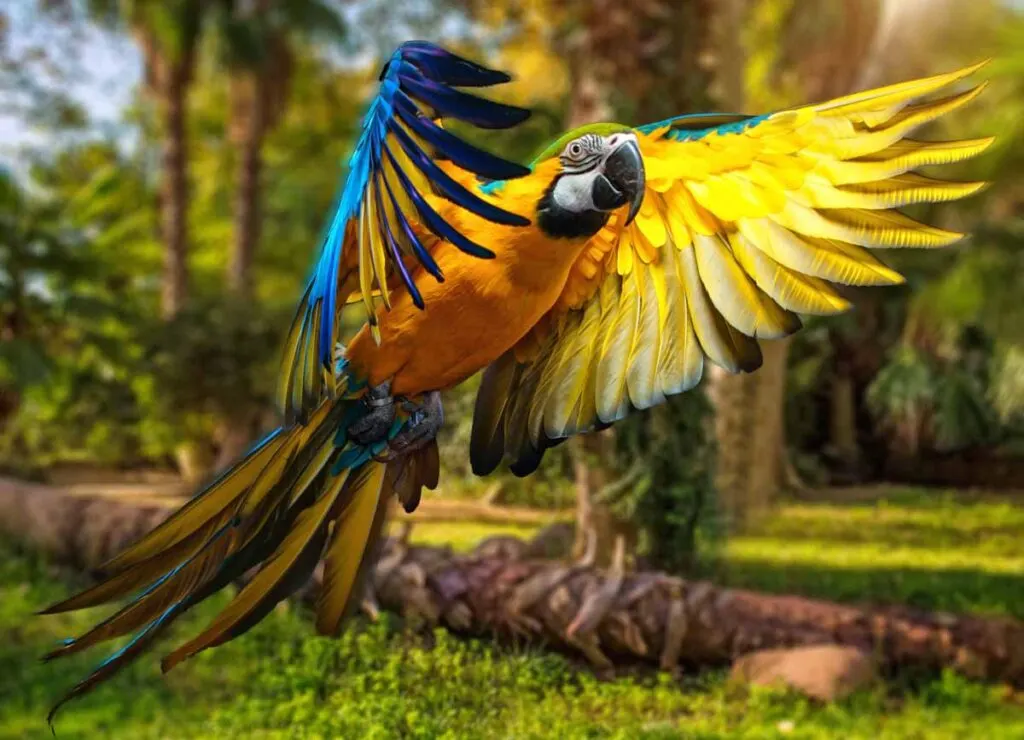
Parrots are colorful birds in the order Psittaciformes.
Although using scientific or academic terms in a conversation is always impressive, it’s more helpful and interesting to know what makes a parrot a parrot.
This type of bird must have a curved beak to be classified as part of the parrot family, and all types of parrots have zygodactyl feet. That’s a scientific term for having four toes, with two facing backward and two forward.
The parrot’s curved beak is one of its most distinctive features, and they use it so much it’s almost like an extra limb.
With over 401 species around the world, parrots are distributed over tropical regions in the Americas, Africa, Asia, and Australia, but most of them are in South America and Australasia.
Different species: hyacinth macaw, scarlet macaw, military macaw, and sun parakeet
Passerines (Passeriformes)
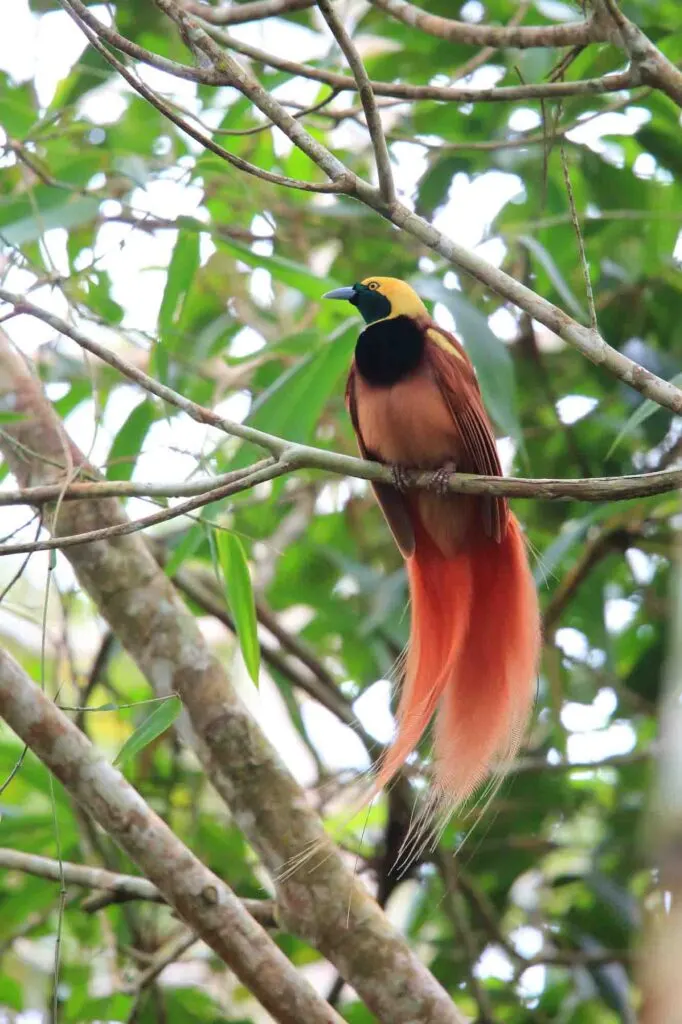
Passerines are types of birds in the Passeriformes order, which enclose more than half of all types of birds (including sparrows, finches, warblers, birds-of-paradise, wrens, and many others).
With far more than 6,500 species of perching birds, this order is by far the largest of terrestrial vertebrates. (The biggest bird family is the Tyrannidae, with over 400 species.)
Passerines are divided into three clades: Acanthisitti (New Zealand wrens), Tyranni (mostly South American suboscines), and Passeri (oscines or songbirds).
The passerines contain several groups of brood parasites, such as the viduas, cuckoo-finches, and cowbirds.
Most passerines are omnivorous, though shrikes are carnivorous, and others are insectivorous.
Different species: hooded crow, blue jay, New Zealand wren, barn swallow, house sparrow, Asian fairy-bluebird, and magnificent riflebird.
Facts About Some Bird Types
As birds grow up, some of them change their eye color. This adaptation helps these types of birds recognize maturity and, therefore, the suitability of a potential mate. It’s like they’re showing off that they’re all grown up and ready to find a mate.
Flamingos have a funny way of eating – they can only chow down on their food when their heads are upside down!
Did you know that birds actually came from reptiles? The earliest bird we know about is the Archaeopteryx, which lived a whopping 147 million years ago. It looked way different from today’s birds and even had a long bony tail and teeth!
The biggest bird in the world is the ostrich, and it can’t fly, but it can reach a super impressive height of 8.8 feet and lay the largest bird eggs, weighing up to 2.2 pounds!
On the flip side, the smallest living bird is the bee hummingbird. It’s so tiny, measuring only 2.1 inches long and weighing less than half an ounce. And guess what? It lays the tiniest eggs – they’re as small as peas!
Here’s a fun fact about eggs – if a chicken has dark earlobes, it’ll produce brown eggs, but if it has white earlobes, it’ll lay white eggs.
Birds have super-fast heartbeats! Depending on the bird and the temperature, their heart rates can range from 100 beats per minute at rest to a whopping 1,200 beats per minute while flying!
Have you ever heard of a poisonous bird? The Pitohui from Papua, New Guinea, is the only known poisonous bird in the world. Its skin and feathers have poison in them – yikes!
Pigeons were the heroes of the World Wars, acting as messengers when communication methods were unreliable. Over 300,000 pigeons were used during the wars, and 32 of them even received a special medal!
Penguins are not just great swimmers – they can also jump up to 9 feet in the air! How cool is that?
The Peregrine Falcon is the speediest bird around. When it goes into a hunting dive, it can reach an incredible speed of 242 mph! And in regular flight, the common Swift holds the record at 105 mph.
Albatrosses are unique because they can sleep while flying! They doze off while cruising at a speedy 25 mph.
Meet the chatterbox of the bird world – the African Gray Parrot! It can learn over 800 words, while most other parrots can only manage around 50.
The Madagascar Pochard is the rarest bird in the world, with only around 25 left in the wild. On the other hand, domestic chickens are everywhere!
Owls can’t move their eyes as we do, but they make up for it by rotating their heads a mind-blowing 270°. It gives them an incredible 360° vision!
The cutest birds alive, ahem, I mean, puffins, are not just great flyers; they can “fly” underwater, too! How adorable is that?
Woodpeckers are pros at pecking. They can peck a whopping twenty times a second at a speed of around 15 mph. Talk about hard work – they can peck 12,000 times per day!
Did you enjoy learning more about these types of birds? Then, be sure to share this article with your friends and help spread the word about these wonderful creatures!
